2022年建设银行秋季招聘试卷
题目总数:157
总分数:157
时间:不限时
第 1 题
单选题
(1)近年来,一个个“热词”聚焦社会热点,体现时代变化,蕴含着人们对自身生活、社会变革与人类发展的理性思考
(2)人们从“八项规定”“两学一做”中看到了我们党实现自我净化的努力,从“一带一路”“天宫二号”中看到了国家的发展进步,从“洪荒之力”“厉害了我的哥”中看到了流行文化的变化,也从“获得感”“撸起袖子加油干”中感受到了百姓的期待……
(3)读懂一个时代,应该从读懂它的语言开始
(4)在网络时代,语言成为社会发展的忠实记录仪和显微镜
(5)语言不仅是从历史继承而来的财富,而且保持着与时代最为紧密的互动
(6)语言既折射时代变迁,又在与时代的互动中,不断丰富着自身
将以上6个句子重新排列,语序正确的是( )。
(2)人们从“八项规定”“两学一做”中看到了我们党实现自我净化的努力,从“一带一路”“天宫二号”中看到了国家的发展进步,从“洪荒之力”“厉害了我的哥”中看到了流行文化的变化,也从“获得感”“撸起袖子加油干”中感受到了百姓的期待……
(3)读懂一个时代,应该从读懂它的语言开始
(4)在网络时代,语言成为社会发展的忠实记录仪和显微镜
(5)语言不仅是从历史继承而来的财富,而且保持着与时代最为紧密的互动
(6)语言既折射时代变迁,又在与时代的互动中,不断丰富着自身
将以上6个句子重新排列,语序正确的是( )。
A.
(5)(4)(1)(2)(6)(3)
B.
(5)(3)(6)(4)(1)(2)
C.
(3)(5)(4)(6)(2)(1)
D.
(4)(5)(1)(2)(6)(3)
第 2 题
单选题
在新闻生产系统的重构中,有两个动向尤为值得关注:第一,机器成为新闻生产者;第二,新闻信息存储、分析、加工系统可能脱离专业媒体而独立存在。2015年Facebook发布的“即时新闻”系统、谷歌发布的“新闻实验室”系统以及2016年今日头条发布的“媒体实验室”,都是非媒体平台提供的媒体化工具。它们共同展现了未来的可能性。在大数据、云计算等技术的推动下,这样一种趋势可能会加剧,未来以数据为核心的新闻信息处理系统,甚至可能存在于云端。
文中提出的“这样一种趋势”,主要是指( )。
文中提出的“这样一种趋势”,主要是指( )。
A.
新闻生产系统的重构将导致新闻生产与新闻分发出现分离
B.
未来的新闻信息处理系统以数据为核心
C.
大数据、云计算在新闻处理中会越来越重要
D.
非媒体平台提供的媒体化工具
第 3 题
单选题
随着基因技术的发展,人类对自己的认识从来没有像今天这么明了。然而人类在不断揭开自身和生物界秘密的同时,伴随着深深的忧虑。英国哲学家罗素曾经说过,科学提高了人类控制大自然的能力,同时据此认为会增加人类的快乐和富足。这种情形只能建立在理性的基础上,但实际上,人类总是被激情和才能所束缚。
文中引用罗素的话,意在说明( )。
文中引用罗素的话,意在说明( )。
A.
在人类理性的基础上,科学能为人类造福
B.
如果脱离了理性的制约,科学有可能危害人类
C.
科学能增加人类的快乐和富足
D.
科学提高了人类控制大自然的能力
第 4 题
单选题
96年前,中国革命的红船从嘉兴南湖扬帆起航、披荆斩棘、破浪前行;96年后,习近平总书记在瞻仰南湖红船时深情地说:“秀水泱泱,红船依旧;时代变迁,精神永恒。”
下列古语中,与之蕴含的哲理一致的是( )。
下列古语中,与之蕴含的哲理一致的是( )。
A.
其作始也简,其将毕也必巨
B.
明镜所以照形,古事所以知今
C.
艰难困苦,玉汝于成
D.
风定花犹落,鸟鸣山更幽
第 5 题
单选题
《2018年中国人工智能行业研究报告》中将人工智能定义为:通过计算机实现人的头脑思维所产生的效果,能够从环境中获取感知并执行行动的智能体的描述和构建。
下列对“人工智能”定义的理解,正确的一项是( )。
下列对“人工智能”定义的理解,正确的一项是( )。
A.
人工智能是计算机对环境的描述和构建
B.
人工智能是能感知行动的智能体
C.
人工智能是对计算机思维的实现
D.
人工智能是对一种智能体的描述和构建
第 6 题
单选题
下列各句中,有语病的一项是( )。
A.
《国家宝藏》演绎文物的故事,对一件件文物的历史进行梳理,让观众在懂得如何欣赏文物之美的同时,也了解到文物所承载的中华文化。
B.
尤瓦尔·赫拉利写作的《人类简史》一经上市就登上了以色列畅销书排行榜第一位,蝉联榜首长达100周,30多个国家争相购买版权。
C.
外卖小哥雷海为十三年刻苦读诗背诗,终换来他完成人生中最美的经历——站在央视的舞台并成为第三季《中国诗词大会》总决赛冠军。
D.
我国自主建设的北斗卫星全球组网稳步推进,应用也已走出国门,不仅服务亚太地区,而且逐步向全球提供服务。
第 7 题
单选题
近日,互联网租房平台频现“甲醛房”乱象,引发社会热议。“甲醛房”带来的困扰,提醒人们思考“互联网+”的另一面。的确,“互联网+”降低了交易成本,为传统的租房市场注入了新活力。“指尖一点、拎包入住”的模式,也给租户带来了便捷体验。但网络推送的信息,真实性、完整性可能存在问题;隔空进行的交易,规范约束、责任边界也相对模糊。这提醒人们,“互联网+”是一种技术和媒介,其对传统行业的改造或影响并不是尽善尽美的。
从文中可见,作者对“互联网+”的态度是( )。
从文中可见,作者对“互联网+”的态度是( )。
A.
理性
B.
不清楚
C.
否定
D.
赞赏
第 8 题
单选题
蒙田说:“初学者的无知在于未学,而学者的无知在于学后。”意思是说,第一种无知是连字都不识,当然谈不上有学问;第二种无知却是错读了许多书,反而变得无知。“初学者”的无知容易辨别、也容易避免。但是“书读得越多越好”的观点似乎更迷惑人。因此有必要审慎选择阅读的书目,以免读得越多就偏离得越远。
根据这段文字,“初学者的无知”和“学者的无知”( )。
根据这段文字,“初学者的无知”和“学者的无知”( )。
A.
都是求知过程中难以避免的
B.
是两种不同学习经历的反映
C.
既容易区分又经常被混淆
D.
都是缺乏正确引导造成的
第 9 题
单选题
有这样一个故事。同样是两根竹子,前一根做成竹笛,后一根做成晾衣杆。晾衣杆不服气地问竹笛:“我们都是同一座山上的竹子,凭什么我天天日晒雨淋,不值一文,而你却价值不菲呢?”竹笛说:“因为你只挨了一刀,而我却经历了精打细磨。”同出山林的两根竹子,两者鲜明落差的背后,揭示出“打磨”的深刻含义。而反观时下有的年轻干部,他们在顺风顺水顺境面前,能够如鱼得水、大展拳脚,然而遇到困难和挫折的时候,却往往经不起“打磨”,最终会落到和后一根竹子一样的境地。
给这段故事确定一个标题,较为恰当的是( )。
给这段故事确定一个标题,较为恰当的是( )。
A.
经不起“打磨”的人生,便会黯然失色
B.
年轻干部要敢于“打磨”、善于“打磨”、乐于“打磨”
C.
年轻干部须经得起“打磨”
D.
“打磨”是一种追求、一种品质、一种习惯
第 10 题
单选题
好莱坞著名导演克里斯托弗·诺兰执导的科幻电影《星际穿越》,在全世界上映后迅速成为一部“现象级”电影,引发了人们探讨科幻电影乃至理论物理学的热潮。美国加州理工学院的天体物理学家肖恩·卡罗尔在与导演克里斯托弗·诺兰的对话中说,《星际穿越》上映后,就连在扑克牌桌旁边玩牌的陌生人都会过去找他询问有关虫洞和相对论的问题。观众对于其中涉及的有关物理学的疑问显然远远超过了对电影自身剧情的关注。这并不奇怪,因为这可能算得上是世界上第一部基本忠实地展现宇宙中各种奇妙的天体现象的电影,想要理解这部电影需要大量的物理学知识。
下列有关《星际穿越》上映后情况的表述,不正确的一项是( )。
下列有关《星际穿越》上映后情况的表述,不正确的一项是( )。
A.
《星际穿越》在全世界上映后迅速引发了人们探讨科幻电影和理论物理学的热潮,成为一部“现象级”的电影
B.
《星际穿越》上映后,许多观众即便是陌生人也都会向天体物理学家肖恩·卡罗尔与导演克里斯托弗·诺兰请教虫洞和相对论的问题
C.
《星际穿越》上映后,观众关注的焦点不在电影剧情自身,反而是电影中涉及的有关物理学的种种疑问
D.
《星际穿越》基本忠实地展现了宇宙中各种奇妙的天体现象,上映后,人们发现理解这部电影需要了解大量的物理学知识
第 11 题
单选题
金融是现代经济的核心,同时也是复杂系统,因而需要科学正确的思想理论指导。如果说凡事“谋定而后动,知止而有得”,金融这样的复杂系统更是如此。科学正确的金融思想固然来源于金融实践,但“________________”,科学正确的金融思想需要“头脑风暴”,需要在交流碰撞中不断升华。
填入画横线部分最恰当的一句是( )。
填入画横线部分最恰当的一句是( )。
A.
辩则明,思则清
B.
苟无济代心,独善亦何益
C.
大厦之成,非一木之材也
D.
知之者不如好之者,好之者不如乐之者
第 12 题
单选题
今年国庆消费一大亮点是新零售带来的全新消费体验。但究竟何为新零售并没有一个准确的定义。专业的说法是“人、货、场在互联网和大数据下的重构”,通俗地理解就是线上和线下结合,然后辅之以人工智能、大数据、云计算等技术手段,对传统零售业的生产销售等环节实现全方位的升级改造。
以下说法可以从材料中推出的是( )。
以下说法可以从材料中推出的是( )。
A.
新零售能够弥补传统零售业线下销售渠道单一的不足
B.
新零售大量运用高科技,能够有效降低传统人力成本
C.
人工智能等新技术的出现是实现新零售的必要条件
D.
传统电商的增长瓶颈是推动新零售落地的动力
第 13 题
单选题
“大英博物馆100件文物中的世界史”展览在中国国家博物馆展出,用百件展品共同讲述200万年来人类文明的历程,如“0号展品”是一套古埃及木棺,制作它的全部材料分别来自黎巴嫩、阿富汗和两河流域。按照该展惯例,每至一个国家,都将吸纳一件(组)该国文物作为第101号一起展出,此前澳大利亚站选取的是“全球第一个wifi设备”,中国北京站选取的第101号文物是“宣布中国加入世贸组织的木槌和中国重返世贸组织的签字笔”。
由所选展品推断,最符合该展主旨的是( )。
由所选展品推断,最符合该展主旨的是( )。
A.
文化具有继承性,没有文化的继承就没有文化的积累
B.
创新是文化富有生机和活力的重要保证
C.
资源、技术、思想文化的传播和共享塑造了人类文明
D.
各大洲文明具有独特性和差异性
第 14 题
单选题
机器学习的方法不仅被广泛地应用于理工医学等领域,并且越来越受到社会科学研究者的重视。许多经济学家都认为机器学习会对经济学的发展产生广泛且深远的影响,以至于在不久的将来,机器学习将改变经济学的研究方式。2017年7月发布的《新一代人工智能发展规划》中特别指出要积极推动人工智能与心理学、数学、经济学和社会学等相关学科的交叉融合。由此看来,探讨机器学习对经济学研究方法的影响,既可以帮助我们更好地理解机器学习的内涵,又有利于我们更多地使用机器学习工具以改善经济学研究方法,并在提高研究精准度的同时不断拓展新的研究领域。
这段文字是一篇文章的引言,接下来最可能讲的是( )。
这段文字是一篇文章的引言,接下来最可能讲的是( )。
A.
机器学习如何从不同维度丰富了经济数据
B.
机器学习如何改进经济预测的准确性
C.
机器学习的定义以及分类
D.
机器学习在经济学研究领域的应用案例
第 15 题
单选题
移动互联网时代,平台企业拥有大量用户、掌握海量数据,对社会资源的整合调配能力与其他类型的企业不能同日而语。这一方面使得平台企业具有很强的“公共属性”,一处细小的产品设计都可能影响到公共安全和公共秩序;另一方面,也让平台企业在个人消费者面前具有更大的话语权和更强的议价能力。这两方面特点决定了平台企业必须肩负起更广泛的社会责任,加强自我约束,始终对公众诉求保持敏感,不能仗着自身体量大、用户多就任意挥霍用户信任。如果失去了对生命安全和公共利益的敬畏,网络平台的用户规模再庞大、商业模式再讨巧、算法分配再新颖,也终将行之不远。
作者通过这段文字意在说明( )。
作者通过这段文字意在说明( )。
A.
各社会主体须担负起肩头的责任和应尽的义务,共同达成维护公共利益的共识
B.
安全是所有产品性能和服务质量所构成的一系列“0”前面的那个“1”,一失全无
C.
平台企业必须承担起相应的社会责任,不可将资本思维凌驾于公共利益之上
D.
平台企业打破了行业的边界,形成了资源的整合,推动了经济的增长
第 16 题
单选题
近年来,“诗和远方”渐回公众视野。当今科技发达,物质资源丰富,但随着各类电子产品逐渐渗入人们的生活,很多人终日沉浸于网络,________地偏离了心灵和自然。所以,“面朝大海,春暖花开”仿佛是物质和技术构筑的丛林里的________,给人们带来了自然的气息和心灵的抚慰,引起了无数人的精神共鸣。
填入画横线部分最恰当的一项是( )。
填入画横线部分最恰当的一项是( )。
A.
渐行渐远 丝丝清风
B.
渐行渐远 一股清流
C.
南辕北辙 丝丝清风
D.
南辕北辙 一股清流
第 17 题
单选题
当下中国,数字经济正成为驱动高质量发展、引领经济社会革新的加速器。互联网大范围、深层次地拓展了发展空间,也带来了隐私保护的风险挑战。信息技术推动社会变革与信息安全风险不断加剧的矛盾这一世界性课题,日益摆在我们面前。可以说,平衡好信息开发利用与保护个人信息安全的关系,事关每个人的合法权益,也关乎数字经济能否真正行稳致远。
这段文字主要强调保障数字经济时代( )。
这段文字主要强调保障数字经济时代( )。
A.
个人信息安全的措施
B.
个人信息安全所面临的挑战
C.
个人信息安全的意义
D.
个人信息安全的背景
第 18 题
单选题
110, 523, 422, 734, 633, ( )
A.
312
B.
971
C.
283
D.
164
第 19 题
单选题
受原料价格上涨影响,某品牌同价位的保健品在三家超市都进行了两次提价(第二次提价的百分比是以第一次提价后的价格为基础的)。甲超市第一次提价10%,第二次提价20%;乙超市第一次提价15%,第二次提价15%;丙超市第一次提价12%,第二次提价18%。则提价最多的为( )。
A.
乙超市
B.
丙超市
C.
甲超市
D.
无法确定
第 20 题
单选题
某人用一笔钱买入两年期年化利率为5%的银行理财产品M,两年到期后连本带息再追加10万元又买入一年期年化利率为6%的银行理财产品N,一年到期后共收益3.92万元。则其第一次买入了( )万元的银行理财产品M。
A.
15
B.
20
C.
10
D.
30
第 21 题
单选题
某公司产品6月销售利润为40万元,8月的销售利润比7月增加15.6万元。假设该产品销售利润逐月增加,且6—8月每月利润增长率相同。则每月利润增加率为( )。
A.
20%
B.
30%
C.
40%
D.
50%
第 22 题
单选题
3, 7, 8, 2, ﹣12, ﹣28, ( )
A.
32
B.
16
C.
﹣16
D.
﹣32
第 23 题
单选题
21.3, 64.3, 17.3, ( )
A.
8.7
B.
49.3
C.
58.3
D.
34.5
第 24 题
单选题
在冬奥会志愿者选拔活动中,甲、乙等5人报名参加了A、B、C三个项目的志愿者工作,因工作需要,每个项目仅需一名志愿者,且甲不能参加A、B项目,乙不能参加B、C项目,则共有( )种不同的选拔志愿者的方案。
A.
25
B.
24
C.
21
D.
20
第 25 题
单选题
3, 2, 8, 18, 146, ( )
A.
968
B.
1675
C.
2630
D.
3107
第 26 题
单选题
1,  , 2,
, 2,  ,
,  , ( )
, ( )
 , 2,
, 2,  ,
,  , ( )
, ( )
A.

B.

C.

D.

第 27 题
单选题
有两排座位,前排6个座位,后排7个座位。若安排2人就坐,规定前排中间2个座位不能坐,且此两人始终不能相邻而坐,则有( )种不同的坐法。
A.
93
B.
94
C.
92
D.
96
第 28 题
单选题
﹣8, 16, 4, 10, 7, ( )
A.
8.5
B.
9
C.
12
D.
19
第 29 题
单选题
某公司要完成一项工程,如果单独交给甲项目组,需要y天完成;如果单独交给乙项目组,需要z天完成,若甲、乙两个项目组共同完成该项目,则最短需要( )天。
A.

B.

C.

D.

第 30 题
单选题
-7, 1, ( ), 65, 217, 513
A.
9
B.
11
C.
24
D.
28
第 31 题
单选题
书架的某一层上有138本书,且是按照“3本小说、4本教材、5本工具书、7本科技书、3本小说、4本教材……”的顺序循环从左至右排列的。则该层最右边是一本( )。
A.
教材
B.
工具书
C.
小说
D.
科技书
第 32 题
单选题
某银行组织一次业务应知应会考试,其中甲、乙、丙三个部门的人数和分数情况如下表:

已知甲部门的平均分为75,丙部门的平均分为79,则乙部门的平均分为( )。

已知甲部门的平均分为75,丙部门的平均分为79,则乙部门的平均分为( )。
A.
76
B.
75
C.
74
D.
73
第 33 题
单选题
5, 8, 20, 68, 260, ( )
A.
1028
B.
848
C.
626
D.
440
第 34 题
单选题
某公司推出一款新产品,当每件新产品的售价为3000元时,恰好能售出15万件。若新产品的售价每增加200元时,就要少售出1万件,如果该公司仅售出12万件新产品,则该公司的销售总额为( )亿元。
A.
4.08
B.
4.72
C.
2.88
D.
4.32
第 35 题
单选题
一个人如果是智者,那么他一定是一位谦和的人,而一个人只有常怀律己之心,他才会谦和。但是,如果一个人做不到心有敬畏,那么他就不会常怀律己之心。
由此可以推出( )。
由此可以推出( )。
A.
一个人如果做不到心存敬畏,他就不是一位智者
B.
一个人如果做到心存敬畏,他就会常怀律己之心
C.
一个人如果常怀律己之心,他就是一位智者
D.
一个人如果不常怀律己之心,他一定做不到心存敬畏
第 36 题
单选题
奥卡姆剃刀原理通俗的解释是“能以较少者去完成的事情,若以较多者去做,便是徒劳”,后人把它概括为“如无必要,勿增实体”。这个原理被应用于对理论的取舍。即在同一表象下,比较简单的那个理论更可能是正确的。
根据上述定义,下列未应用奥卡姆剃刀原理的是( )。
根据上述定义,下列未应用奥卡姆剃刀原理的是( )。
A.
由于刑审诉讼遵循无罪推定的原则,定罪需要控方大量举证
B.
否认“以太”的存在可以使很多物理现象得到更简单的解释
C.
与被黑客入侵相比,手机被停机的原因更可能是欠费
D.
老子用“治大国若烹小鲜”解释管理之道
第 37 题
单选题
某市为了发展文化强市战略,在2008年、2010年先后建成了两个图书馆,2008年底共办理市民借书证7万余个,到2010年底共办理市民借书证13万个。2011年,该市又在新区建立了第三个图书馆,于2012年初落成开放。截至2012年底,全市共计办理市民借书证20余万个。市政府由此认为,该项举措是有实效的,因为在短短的4年间,光顾图书馆的市民增加了近两倍。
以下哪项如果为真,最能削弱上述结论?
以下哪项如果为真,最能削弱上述结论?
A.
图书馆要不断购置新书,维护成本也很高,这会影响该市其他文化设施建设
B.
该市有两所高等学校,许多在校生也办理了这3个图书馆的借书证
C.
很多办理了第一个图书馆借书证的市民又办理了另外两个图书馆的借书证
D.
该市新区建设发展迅速,4年间很多外来人口大量涌入新区
第 38 题
问答题
记者采访时的提问要具体、简洁明了,切忌空泛、笼统、不着边际。约翰·布雷迪在《采访技巧》中剖析了记者采访时向访问对象提出诸如“您感觉如何 ”等问题的弊端,认为这些提问“实际上在信息获取上等于原地踏步,它使采访对象没法回答,除非用含混不清或枯燥无味的话来应付。”
由此可以推出( )。
由此可以推出( )。
第 39 题
单选题
建设银行某分行采用课题PK赛的培训新模式形成内部赛马机制,让新员工在实战中学习和历练。小司、小王和小张在申报课题时,一位申报产品创新,一位申报同业体验,一位申报流程优化。据悉,小司不打算申报产品创新,小王不愿意申报同业体验,小张既不喜欢流程优化也不喜欢同业体验。
因此( )。
因此( )。
A.
小司申报了同业体验,小张申报了产品创新,小王申报了流程优化
B.
小张申报了流程优化,小司申报了产品创新,小王申报了同业体验
C.
小王申报了产品创新,小张申报了同业体验,小司申报了流程优化
D.
小张申报了产品创新,小王申报了同业体验,小司申报了流程优化
第 40 题
单选题
经过系统全面的入职培训,建设银行某分行将甲、乙、丙三位新员工分别分配到民主路、团结路、人民路支行工作。大家开始并不知道他们当中究竟谁分配到哪一支行工作,只是作了如下三种猜测:
(1)甲分配到民主路支行工作,乙分配到团结路支行工作;
(2)甲分配到团结路支行工作,丙分配到民主路支行工作;
(3)甲分配到人民路支行工作,乙分配到民主路支行工作。
后来证实,三种猜测都是只猜中了一半。由此可以推出( )。
(1)甲分配到民主路支行工作,乙分配到团结路支行工作;
(2)甲分配到团结路支行工作,丙分配到民主路支行工作;
(3)甲分配到人民路支行工作,乙分配到民主路支行工作。
后来证实,三种猜测都是只猜中了一半。由此可以推出( )。
A.
甲分配到民主路支行工作,乙分配到团结路支行工作,丙分配到人民路支行工作
B.
甲分配到团结路支行工作,乙分配到民主路支行工作,丙分配到人民路支行工作
C.
甲分配到人民路支行工作,乙分配到民主路支行工作,丙分配到团结路支行工作
D.
甲分配到人民路支行工作,乙分配到团结路支行工作,丙分配到民主路支行工作
第 41 题
单选题
赞扬一个历史学家对于具体历史事件阐述的准确性,就如同是在赞扬一个建筑师在完成一座宏伟建筑物时使用了合格的水泥、钢筋和砖瓦,而不是赞扬一个建筑材料供应商提供了合格的水泥、钢筋和砖瓦。
以下哪项最为恰当地概括了题干所要表达的意思 ( )
以下哪项最为恰当地概括了题干所要表达的意思 ( )
A.
一个历史学家必须准确地阐述具体的历史事件,但这并不是他的主要任务
B.
建筑材料供应商和建筑师不同,他的任务仅是提供合格的建筑材料
C.
合格的建筑材料对于完成一座宏伟的建筑是不可缺少的
D.
就如同一个建筑师一样,一个历史学家的成就,不可能脱离其他领域的研究成果
第 42 题
单选题
中国的科研经费持续增长,统计数据显示,2017年中国研发经费投入总量为17500亿元,仅次于美国,居世界第二位。此外,随着一系列国家重点创新项目平台、重点实验室平台、创业人才平台和青年项目平台的陆续建立,今天的中国,已有能力为科研人员提供不输于西方国家的科研条件。
下列各项如果为真,最能加强上述论证的是( )。
下列各项如果为真,最能加强上述论证的是( )。
A.
国家重点创新项目平台、重点实验室平台、创业人才平台和青年项目平台对科研人员极具吸引力
B.
科研经费能够落到实处,各类重点举措使科研人员人尽其才
C.
随着科研经费的提升,中国也随之出台了一系列科研政策
D.
科研经费的提升对于改善科研环境具有举足轻重的作用
第 43 题
单选题
请从所给的四个选项中,选择最合适的一个填入问号处,使之呈现一定的规律性( )。


A.
A
B.
B
C.
C
D.
D
第 44 题
单选题
宇宙加速膨胀是因为物质之间相互排斥,减速膨胀是因为物质之间相互吸引。因此,要在此基础上解释宇宙的加速或减速膨胀,必须要有不同特性的物质在不同的时期占主导地位,从而产生强大的排斥力或吸引力。粒子物理标准模型中的所有粒子都产生吸引性引力,然而星系转动曲线的研究表明,在星系里面还有大量的、看不到的物质,这些物质可以产生非常强大的吸引性引力。
以上论证如果为真,那么星系转动曲线研究结论隐含了下列哪一项前提?
以上论证如果为真,那么星系转动曲线研究结论隐含了下列哪一项前提?
A.
粒子物理标准模型中的所有粒子产生的吸引性引力不足
B.
粒子物理标准模型中的粒子不是唯一的,存在其他粒子
C.
星系转动曲线的研究说明这个时期的宇宙正在加速膨胀
D.
星系转动曲线的研究说明存在超大质量、看不到的黑洞
第 45 题
单选题
所有优秀的客户经理都具有良好的营销技能,王森没有良好的营销技能,所以王森不是优秀的客户经理。
下述推理中与上述推理在结构形式上最为相似的是( )。
下述推理中与上述推理在结构形式上最为相似的是( )。
A.
所有条件适宜的环境都能使企鹅蛋孵化,但F岛上企鹅蛋没有孵化,所以F岛的环境不是适宜的
B.
所有年满七十周岁的人都可以领到老年人生活补贴,刘老师今年七十五周岁,所以他可以领到老年人生活补贴
C.
所有被顶尖高校录取的学生都是聪明的学生,周伟没有被顶尖高校录取,所以周伟不是聪明的学生
D.
R公司今年招聘的新员工都具有良好的综合素质,小吴具有良好的综合素质,所以小吴是今年R公司招聘的新员工
第 46 题
单选题
在一次经济学研讨会上,针对目前国内消费价格上涨的现象,与会的各位专家学者纷纷表达自己的看法。一位经济学家指出,本轮物价上涨主要表现为食品价格的上涨,其根本原因则在于流动性过剩,表现为有过多的货币投放量,这些多余的资金需要寻找投资出路,于是就有了投资或经济过热现象,流动性过剩为当前物价上涨埋下隐患。
以下哪项如果为真,能够削弱上述经济学家的观点?
以下哪项如果为真,能够削弱上述经济学家的观点?
A.
实践证明,当市场上流动性不足时往往导致供过于求,消费价格下调
B.
一项权威调查显示,80%的食品生产者表示成本提高是食品价格上涨的原因
C.
这位经济学家此前在国内的经济学界一直名不见经传
D.
究竟是什么原因导致本轮消费价格上涨还在进一步研究当中
第 47 题
问答题
迭代开发就是由于市场的不确定性高,在需求没被完全确定之前,开发就迅速启动,每次循环不求完美,但求不断发现新问题,获取和积累新知识,并自适应地控制过程,在一次迭代中完成系统的部分功能,然后将未成熟的产品交付给领先用户,通过他们的反馈来进一步细化需求,从而进入下一轮的迭代,不断获取用户需求、完善产品。
根据上述定义,下列不属于迭代开发的一项是:
根据上述定义,下列不属于迭代开发的一项是:
第 48 题
单选题
在一次学术研讨会上,有研究者提出:所有经济问题都属于长期问题,有些经济问题属于信贷问题,所有长期问题都属于历史问题,没有财政问题属于历史问题,有些财政问题属于信贷问题。
以下哪项不能从上述结论中推出 ( )
以下哪项不能从上述结论中推出 ( )
A.
有些信贷问题属于历史问题
B.
没有财政问题属于长期问题
C.
有些经济问题属于财政问题
D.
有些信贷问题不属于财政问题
第 49 题
单选题
国家信息中心发布的《2017中国信息社会发展报告》显示,2017年中国信息社会指数达到0.4749。从信息社会发展的四个重点领域看,在线政府领域发展最快,2017年全国在线政府生活指数达到0.6070,同比增长10.5%。
表 2011—2017年中国信息社会指数趋势

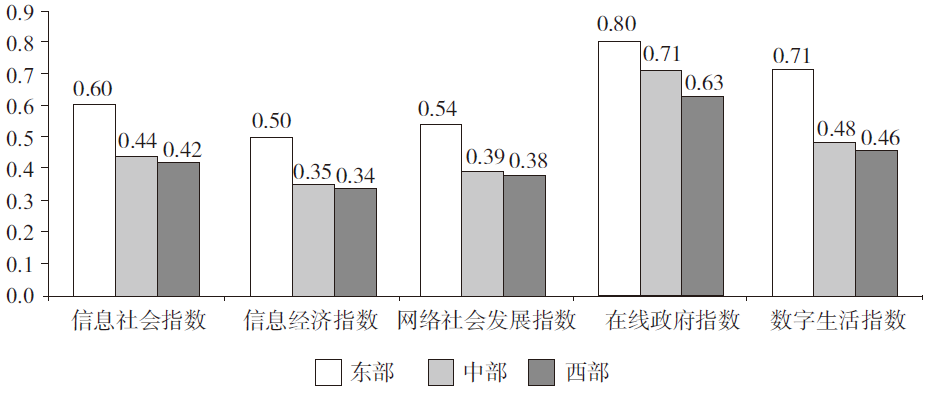
2011—2017年,中国各领域信息社会指数中出现起伏变化的是( )。
表 2011—2017年中国信息社会指数趋势


2011—2017年,中国各领域信息社会指数中出现起伏变化的是( )。
A.
全国信息经济指数
B.
网络社会发展指数
C.
在线政府指数
D.
数字生活指数
第 50 题
单选题
国家信息中心发布的《2017中国信息社会发展报告》显示,2017年中国信息社会指数达到0.4749。从信息社会发展的四个重点领域看,在线政府领域发展最快,2017年全国在线政府生活指数达到0.6070,同比增长10.5%。
表 2011—2017年中国信息社会指数趋势


与2011年相比,2017年我国网络社会发展指数提高了近( )。
表 2011—2017年中国信息社会指数趋势


与2011年相比,2017年我国网络社会发展指数提高了近( )。
A.
1.4倍
B.
0.7倍
C.
3倍
D.
0.4倍
第 51 题
单选题
国家信息中心发布的《2017中国信息社会发展报告》显示,2017年中国信息社会指数达到0.4749。从信息社会发展的四个重点领域看,在线政府领域发展最快,2017年全国在线政府生活指数达到0.6070,同比增长10.5%。
表 2011—2017年中国信息社会指数趋势


2017年,东、中、西部各领域信息社会指数差距最大的是( )。
表 2011—2017年中国信息社会指数趋势


2017年,东、中、西部各领域信息社会指数差距最大的是( )。
A.
信息经济指数
B.
网络社会发展指数
C.
在线政府指数
D.
数字生活指数
第 52 题
单选题
国家信息中心发布的《2017中国信息社会发展报告》显示,2017年中国信息社会指数达到0.4749。从信息社会发展的四个重点领域看,在线政府领域发展最快,2017年全国在线政府生活指数达到0.6070,同比增长10.5%。
表 2011—2017年中国信息社会指数趋势


2017年,西部地区各类指数与全国水平相差的最大值是( )。
表 2011—2017年中国信息社会指数趋势


2017年,西部地区各类指数与全国水平相差的最大值是( )。
A.
0.0843
B.
0.0712
C.
0.0549
D.
0.0450
第 53 题
单选题
国家信息中心发布的《2017中国信息社会发展报告》显示,2017年中国信息社会指数达到0.4749。从信息社会发展的四个重点领域看,在线政府领域发展最快,2017年全国在线政府生活指数达到0.6070,同比增长10.5%。
表 2011—2017年中国信息社会指数趋势


根据资料,下列说法错误的是( )。
表 2011—2017年中国信息社会指数趋势


根据资料,下列说法错误的是( )。
A.
2011—2017年,从四个重点领域看,发展最慢的是在线政府指数
B.
2017年信息社会指数及四大领域指数中,中部地区均处于中等水平
C.
2011—2017年,从四个重点领域看,数字生活指数发展最快
D.
2017年,在信息社会指数及四大领域指数中,东部地区有部分指数低于全国平均水平
第 54 题
单选题
总体来看,2017年我国跨境资金流动形势明显好转,外汇市场供求趋向基本平衡。
从银行结售汇数据看,2017年,银行累计结汇110 884亿元人民币(等值16 441亿美元),按美元计价,剔除汇率因素影响(下同),同比增长14%,累计售汇118 532亿元人民币(等值17 557亿美元),同比下降1%,累计结售汇逆差7648亿元人民币(等值1 116亿美元),同比下降67%。其中,银行代客累计结汇105 303亿元人民币,累计售汇110 065亿元人民币,累计结售汇逆差4 762亿元人民币,银行自身累计结汇5 581亿元人民币,累计售汇8 467亿元人民币,累计结售汇逆差2 886亿元人民币。一季度银行结售汇逆差409亿美元,二季度升至530亿美元,三季度逆差收窄至190亿美元,四季度转为顺差12亿美元。同期,银行代客累计远期结汇签约9 993亿元人民币,累计远期售汇签约11 682亿元人民币,累计远期净售汇1 689亿元人民币。
从银行代客涉外收付款数据看,2017年,银行代客累计涉外收入202 081亿元人民币(等值29 969亿美元),同比增长7%,累计对外付款210 561亿元人民币(等值31 213亿美元),同比增长1%,累计涉外收付款逆差8 480亿元人民币(等值1 245亿美元),同比下降59%。一季度、二季度累计涉外收付款逆差分别为252亿和590亿美元,三季度、四季度逆差分别收窄至273亿美元和130亿美元。衡量购汇意愿的售汇率,也就是客户从银行买汇与客户涉外外汇支出之比为65%,较2016年下降9个百分点,其中一季度至四季度逐季回落,一季度68%、二季度67%、三季度63%、四季度62%;衡量企业和个人结汇意愿的结汇率,也就是客户向银行卖出外汇与客户涉外外汇收入之比为63%,较2016年上升3个百分点,其中,一季度至四季度分别为62%、63%、64%和62%。
注:上述资料统计时,不同币种间价格换算采用当年平均汇率。
2016年,银行累计结售汇逆差约为( )。
从银行结售汇数据看,2017年,银行累计结汇110 884亿元人民币(等值16 441亿美元),按美元计价,剔除汇率因素影响(下同),同比增长14%,累计售汇118 532亿元人民币(等值17 557亿美元),同比下降1%,累计结售汇逆差7648亿元人民币(等值1 116亿美元),同比下降67%。其中,银行代客累计结汇105 303亿元人民币,累计售汇110 065亿元人民币,累计结售汇逆差4 762亿元人民币,银行自身累计结汇5 581亿元人民币,累计售汇8 467亿元人民币,累计结售汇逆差2 886亿元人民币。一季度银行结售汇逆差409亿美元,二季度升至530亿美元,三季度逆差收窄至190亿美元,四季度转为顺差12亿美元。同期,银行代客累计远期结汇签约9 993亿元人民币,累计远期售汇签约11 682亿元人民币,累计远期净售汇1 689亿元人民币。
从银行代客涉外收付款数据看,2017年,银行代客累计涉外收入202 081亿元人民币(等值29 969亿美元),同比增长7%,累计对外付款210 561亿元人民币(等值31 213亿美元),同比增长1%,累计涉外收付款逆差8 480亿元人民币(等值1 245亿美元),同比下降59%。一季度、二季度累计涉外收付款逆差分别为252亿和590亿美元,三季度、四季度逆差分别收窄至273亿美元和130亿美元。衡量购汇意愿的售汇率,也就是客户从银行买汇与客户涉外外汇支出之比为65%,较2016年下降9个百分点,其中一季度至四季度逐季回落,一季度68%、二季度67%、三季度63%、四季度62%;衡量企业和个人结汇意愿的结汇率,也就是客户向银行卖出外汇与客户涉外外汇收入之比为63%,较2016年上升3个百分点,其中,一季度至四季度分别为62%、63%、64%和62%。
注:上述资料统计时,不同币种间价格换算采用当年平均汇率。
2016年,银行累计结售汇逆差约为( )。
A.
12772亿元人民币
B.
4580亿元人民币
C.
1864亿美元
D.
3382亿美元
第 55 题
单选题
总体来看,2017年我国跨境资金流动形势明显好转,外汇市场供求趋向基本平衡。
从银行结售汇数据看,2017年,银行累计结汇110 884亿元人民币(等值16 441亿美元),按美元计价,剔除汇率因素影响(下同),同比增长14%,累计售汇118 532亿元人民币(等值17 557亿美元),同比下降1%,累计结售汇逆差7648亿元人民币(等值1 116亿美元),同比下降67%。其中,银行代客累计结汇105 303亿元人民币,累计售汇110 065亿元人民币,累计结售汇逆差4 762亿元人民币,银行自身累计结汇5 581亿元人民币,累计售汇8 467亿元人民币,累计结售汇逆差2 886亿元人民币。一季度银行结售汇逆差409亿美元,二季度升至530亿美元,三季度逆差收窄至190亿美元,四季度转为顺差12亿美元。同期,银行代客累计远期结汇签约9 993亿元人民币,累计远期售汇签约11 682亿元人民币,累计远期净售汇1 689亿元人民币。
从银行代客涉外收付款数据看,2017年,银行代客累计涉外收入202 081亿元人民币(等值29 969亿美元),同比增长7%,累计对外付款210 561亿元人民币(等值31 213亿美元),同比增长1%,累计涉外收付款逆差8 480亿元人民币(等值1 245亿美元),同比下降59%。一季度、二季度累计涉外收付款逆差分别为252亿和590亿美元,三季度、四季度逆差分别收窄至273亿美元和130亿美元。衡量购汇意愿的售汇率,也就是客户从银行买汇与客户涉外外汇支出之比为65%,较2016年下降9个百分点,其中一季度至四季度逐季回落,一季度68%、二季度67%、三季度63%、四季度62%;衡量企业和个人结汇意愿的结汇率,也就是客户向银行卖出外汇与客户涉外外汇收入之比为63%,较2016年上升3个百分点,其中,一季度至四季度分别为62%、63%、64%和62%。
注:上述资料统计时,不同币种间价格换算采用当年平均汇率。
2017年,100美元的年平均价约为( )元人民币。
从银行结售汇数据看,2017年,银行累计结汇110 884亿元人民币(等值16 441亿美元),按美元计价,剔除汇率因素影响(下同),同比增长14%,累计售汇118 532亿元人民币(等值17 557亿美元),同比下降1%,累计结售汇逆差7648亿元人民币(等值1 116亿美元),同比下降67%。其中,银行代客累计结汇105 303亿元人民币,累计售汇110 065亿元人民币,累计结售汇逆差4 762亿元人民币,银行自身累计结汇5 581亿元人民币,累计售汇8 467亿元人民币,累计结售汇逆差2 886亿元人民币。一季度银行结售汇逆差409亿美元,二季度升至530亿美元,三季度逆差收窄至190亿美元,四季度转为顺差12亿美元。同期,银行代客累计远期结汇签约9 993亿元人民币,累计远期售汇签约11 682亿元人民币,累计远期净售汇1 689亿元人民币。
从银行代客涉外收付款数据看,2017年,银行代客累计涉外收入202 081亿元人民币(等值29 969亿美元),同比增长7%,累计对外付款210 561亿元人民币(等值31 213亿美元),同比增长1%,累计涉外收付款逆差8 480亿元人民币(等值1 245亿美元),同比下降59%。一季度、二季度累计涉外收付款逆差分别为252亿和590亿美元,三季度、四季度逆差分别收窄至273亿美元和130亿美元。衡量购汇意愿的售汇率,也就是客户从银行买汇与客户涉外外汇支出之比为65%,较2016年下降9个百分点,其中一季度至四季度逐季回落,一季度68%、二季度67%、三季度63%、四季度62%;衡量企业和个人结汇意愿的结汇率,也就是客户向银行卖出外汇与客户涉外外汇收入之比为63%,较2016年上升3个百分点,其中,一季度至四季度分别为62%、63%、64%和62%。
注:上述资料统计时,不同币种间价格换算采用当年平均汇率。
2017年,100美元的年平均价约为( )元人民币。
A.
674
B.
723
C.
615
D.
650
第 56 题
单选题
总体来看,2017年我国跨境资金流动形势明显好转,外汇市场供求趋向基本平衡。
从银行结售汇数据看,2017年,银行累计结汇110 884亿元人民币(等值16 441亿美元),按美元计价,剔除汇率因素影响(下同),同比增长14%,累计售汇118 532亿元人民币(等值17 557亿美元),同比下降1%,累计结售汇逆差7648亿元人民币(等值1 116亿美元),同比下降67%。其中,银行代客累计结汇105 303亿元人民币,累计售汇110 065亿元人民币,累计结售汇逆差4 762亿元人民币,银行自身累计结汇5 581亿元人民币,累计售汇8 467亿元人民币,累计结售汇逆差2 886亿元人民币。一季度银行结售汇逆差409亿美元,二季度升至530亿美元,三季度逆差收窄至190亿美元,四季度转为顺差12亿美元。同期,银行代客累计远期结汇签约9 993亿元人民币,累计远期售汇签约11 682亿元人民币,累计远期净售汇1 689亿元人民币。
从银行代客涉外收付款数据看,2017年,银行代客累计涉外收入202 081亿元人民币(等值29 969亿美元),同比增长7%,累计对外付款210 561亿元人民币(等值31 213亿美元),同比增长1%,累计涉外收付款逆差8 480亿元人民币(等值1 245亿美元),同比下降59%。一季度、二季度累计涉外收付款逆差分别为252亿和590亿美元,三季度、四季度逆差分别收窄至273亿美元和130亿美元。衡量购汇意愿的售汇率,也就是客户从银行买汇与客户涉外外汇支出之比为65%,较2016年下降9个百分点,其中一季度至四季度逐季回落,一季度68%、二季度67%、三季度63%、四季度62%;衡量企业和个人结汇意愿的结汇率,也就是客户向银行卖出外汇与客户涉外外汇收入之比为63%,较2016年上升3个百分点,其中,一季度至四季度分别为62%、63%、64%和62%。
注:上述资料统计时,不同币种间价格换算采用当年平均汇率。
剔除汇率因素影响,2017年下列项目中,同比涨跌幅度最小的是( )。
从银行结售汇数据看,2017年,银行累计结汇110 884亿元人民币(等值16 441亿美元),按美元计价,剔除汇率因素影响(下同),同比增长14%,累计售汇118 532亿元人民币(等值17 557亿美元),同比下降1%,累计结售汇逆差7648亿元人民币(等值1 116亿美元),同比下降67%。其中,银行代客累计结汇105 303亿元人民币,累计售汇110 065亿元人民币,累计结售汇逆差4 762亿元人民币,银行自身累计结汇5 581亿元人民币,累计售汇8 467亿元人民币,累计结售汇逆差2 886亿元人民币。一季度银行结售汇逆差409亿美元,二季度升至530亿美元,三季度逆差收窄至190亿美元,四季度转为顺差12亿美元。同期,银行代客累计远期结汇签约9 993亿元人民币,累计远期售汇签约11 682亿元人民币,累计远期净售汇1 689亿元人民币。
从银行代客涉外收付款数据看,2017年,银行代客累计涉外收入202 081亿元人民币(等值29 969亿美元),同比增长7%,累计对外付款210 561亿元人民币(等值31 213亿美元),同比增长1%,累计涉外收付款逆差8 480亿元人民币(等值1 245亿美元),同比下降59%。一季度、二季度累计涉外收付款逆差分别为252亿和590亿美元,三季度、四季度逆差分别收窄至273亿美元和130亿美元。衡量购汇意愿的售汇率,也就是客户从银行买汇与客户涉外外汇支出之比为65%,较2016年下降9个百分点,其中一季度至四季度逐季回落,一季度68%、二季度67%、三季度63%、四季度62%;衡量企业和个人结汇意愿的结汇率,也就是客户向银行卖出外汇与客户涉外外汇收入之比为63%,较2016年上升3个百分点,其中,一季度至四季度分别为62%、63%、64%和62%。
注:上述资料统计时,不同币种间价格换算采用当年平均汇率。
剔除汇率因素影响,2017年下列项目中,同比涨跌幅度最小的是( )。
A.
银行代客累计涉外收入
B.
银行代客累计对外付款
C.
银行累计结售汇逆差
D.
银行累计结汇
第 57 题
单选题
总体来看,2017年我国跨境资金流动形势明显好转,外汇市场供求趋向基本平衡。
从银行结售汇数据看,2017年,银行累计结汇110 884亿元人民币(等值16 441亿美元),按美元计价,剔除汇率因素影响(下同),同比增长14%,累计售汇118 532亿元人民币(等值17 557亿美元),同比下降1%,累计结售汇逆差7648亿元人民币(等值1 116亿美元),同比下降67%。其中,银行代客累计结汇105 303亿元人民币,累计售汇110 065亿元人民币,累计结售汇逆差4 762亿元人民币,银行自身累计结汇5 581亿元人民币,累计售汇8 467亿元人民币,累计结售汇逆差2 886亿元人民币。一季度银行结售汇逆差409亿美元,二季度升至530亿美元,三季度逆差收窄至190亿美元,四季度转为顺差12亿美元。同期,银行代客累计远期结汇签约9 993亿元人民币,累计远期售汇签约11 682亿元人民币,累计远期净售汇1 689亿元人民币。
从银行代客涉外收付款数据看,2017年,银行代客累计涉外收入202 081亿元人民币(等值29 969亿美元),同比增长7%,累计对外付款210 561亿元人民币(等值31 213亿美元),同比增长1%,累计涉外收付款逆差8 480亿元人民币(等值1 245亿美元),同比下降59%。一季度、二季度累计涉外收付款逆差分别为252亿和590亿美元,三季度、四季度逆差分别收窄至273亿美元和130亿美元。衡量购汇意愿的售汇率,也就是客户从银行买汇与客户涉外外汇支出之比为65%,较2016年下降9个百分点,其中一季度至四季度逐季回落,一季度68%、二季度67%、三季度63%、四季度62%;衡量企业和个人结汇意愿的结汇率,也就是客户向银行卖出外汇与客户涉外外汇收入之比为63%,较2016年上升3个百分点,其中,一季度至四季度分别为62%、63%、64%和62%。
注:上述资料统计时,不同币种间价格换算采用当年平均汇率。
2016年,银行代客结汇率较售汇率( )。
从银行结售汇数据看,2017年,银行累计结汇110 884亿元人民币(等值16 441亿美元),按美元计价,剔除汇率因素影响(下同),同比增长14%,累计售汇118 532亿元人民币(等值17 557亿美元),同比下降1%,累计结售汇逆差7648亿元人民币(等值1 116亿美元),同比下降67%。其中,银行代客累计结汇105 303亿元人民币,累计售汇110 065亿元人民币,累计结售汇逆差4 762亿元人民币,银行自身累计结汇5 581亿元人民币,累计售汇8 467亿元人民币,累计结售汇逆差2 886亿元人民币。一季度银行结售汇逆差409亿美元,二季度升至530亿美元,三季度逆差收窄至190亿美元,四季度转为顺差12亿美元。同期,银行代客累计远期结汇签约9 993亿元人民币,累计远期售汇签约11 682亿元人民币,累计远期净售汇1 689亿元人民币。
从银行代客涉外收付款数据看,2017年,银行代客累计涉外收入202 081亿元人民币(等值29 969亿美元),同比增长7%,累计对外付款210 561亿元人民币(等值31 213亿美元),同比增长1%,累计涉外收付款逆差8 480亿元人民币(等值1 245亿美元),同比下降59%。一季度、二季度累计涉外收付款逆差分别为252亿和590亿美元,三季度、四季度逆差分别收窄至273亿美元和130亿美元。衡量购汇意愿的售汇率,也就是客户从银行买汇与客户涉外外汇支出之比为65%,较2016年下降9个百分点,其中一季度至四季度逐季回落,一季度68%、二季度67%、三季度63%、四季度62%;衡量企业和个人结汇意愿的结汇率,也就是客户向银行卖出外汇与客户涉外外汇收入之比为63%,较2016年上升3个百分点,其中,一季度至四季度分别为62%、63%、64%和62%。
注:上述资料统计时,不同币种间价格换算采用当年平均汇率。
2016年,银行代客结汇率较售汇率( )。
A.
低2个百分点
B.
高2个百分点
C.
低14个百分点
D.
高14个百分点
第 58 题
单选题
总体来看,2017年我国跨境资金流动形势明显好转,外汇市场供求趋向基本平衡。
从银行结售汇数据看,2017年,银行累计结汇110 884亿元人民币(等值16 441亿美元),按美元计价,剔除汇率因素影响(下同),同比增长14%,累计售汇118 532亿元人民币(等值17 557亿美元),同比下降1%,累计结售汇逆差7648亿元人民币(等值1 116亿美元),同比下降67%。其中,银行代客累计结汇105 303亿元人民币,累计售汇110 065亿元人民币,累计结售汇逆差4 762亿元人民币,银行自身累计结汇5 581亿元人民币,累计售汇8 467亿元人民币,累计结售汇逆差2 886亿元人民币。一季度银行结售汇逆差409亿美元,二季度升至530亿美元,三季度逆差收窄至190亿美元,四季度转为顺差12亿美元。同期,银行代客累计远期结汇签约9 993亿元人民币,累计远期售汇签约11 682亿元人民币,累计远期净售汇1 689亿元人民币。
从银行代客涉外收付款数据看,2017年,银行代客累计涉外收入202 081亿元人民币(等值29 969亿美元),同比增长7%,累计对外付款210 561亿元人民币(等值31 213亿美元),同比增长1%,累计涉外收付款逆差8 480亿元人民币(等值1 245亿美元),同比下降59%。一季度、二季度累计涉外收付款逆差分别为252亿和590亿美元,三季度、四季度逆差分别收窄至273亿美元和130亿美元。衡量购汇意愿的售汇率,也就是客户从银行买汇与客户涉外外汇支出之比为65%,较2016年下降9个百分点,其中一季度至四季度逐季回落,一季度68%、二季度67%、三季度63%、四季度62%;衡量企业和个人结汇意愿的结汇率,也就是客户向银行卖出外汇与客户涉外外汇收入之比为63%,较2016年上升3个百分点,其中,一季度至四季度分别为62%、63%、64%和62%。
注:上述资料统计时,不同币种间价格换算采用当年平均汇率。
根据资料,下列说法正确的是( )。
从银行结售汇数据看,2017年,银行累计结汇110 884亿元人民币(等值16 441亿美元),按美元计价,剔除汇率因素影响(下同),同比增长14%,累计售汇118 532亿元人民币(等值17 557亿美元),同比下降1%,累计结售汇逆差7648亿元人民币(等值1 116亿美元),同比下降67%。其中,银行代客累计结汇105 303亿元人民币,累计售汇110 065亿元人民币,累计结售汇逆差4 762亿元人民币,银行自身累计结汇5 581亿元人民币,累计售汇8 467亿元人民币,累计结售汇逆差2 886亿元人民币。一季度银行结售汇逆差409亿美元,二季度升至530亿美元,三季度逆差收窄至190亿美元,四季度转为顺差12亿美元。同期,银行代客累计远期结汇签约9 993亿元人民币,累计远期售汇签约11 682亿元人民币,累计远期净售汇1 689亿元人民币。
从银行代客涉外收付款数据看,2017年,银行代客累计涉外收入202 081亿元人民币(等值29 969亿美元),同比增长7%,累计对外付款210 561亿元人民币(等值31 213亿美元),同比增长1%,累计涉外收付款逆差8 480亿元人民币(等值1 245亿美元),同比下降59%。一季度、二季度累计涉外收付款逆差分别为252亿和590亿美元,三季度、四季度逆差分别收窄至273亿美元和130亿美元。衡量购汇意愿的售汇率,也就是客户从银行买汇与客户涉外外汇支出之比为65%,较2016年下降9个百分点,其中一季度至四季度逐季回落,一季度68%、二季度67%、三季度63%、四季度62%;衡量企业和个人结汇意愿的结汇率,也就是客户向银行卖出外汇与客户涉外外汇收入之比为63%,较2016年上升3个百分点,其中,一季度至四季度分别为62%、63%、64%和62%。
注:上述资料统计时,不同币种间价格换算采用当年平均汇率。
根据资料,下列说法正确的是( )。
A.
2017年三季度银行结售汇逆差超过全年银行结售汇逆差的二成
B.
2017年银行代客累计涉外收入增长额小于银行代客累计对外付款增长额
C.
2017年银行代客累计远期净售汇金额小于银行自身累计结汇金额
D.
2017年客户涉外外汇收入不超过15万亿元人民币
第 59 题
单选题
表1 2018年6月全国铁路主要指标完成情况
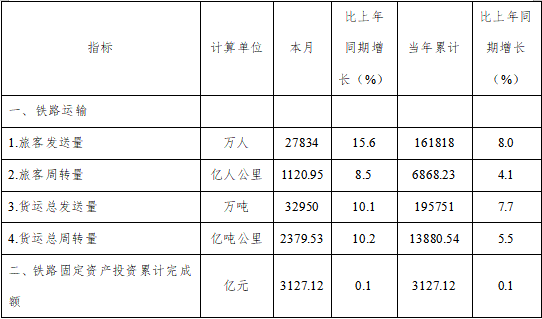
表2 2018年7月全国铁路主要指标完成情况
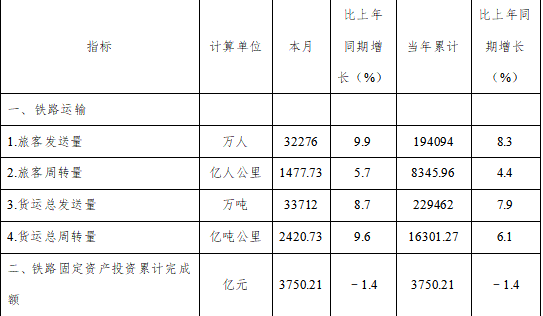
表3 2018年8月全国铁路主要指标完成情况

2018年6—8月,全国铁路共完成旅客发送量( )万人。

表2 2018年7月全国铁路主要指标完成情况

表3 2018年8月全国铁路主要指标完成情况

2018年6—8月,全国铁路共完成旅客发送量( )万人。
A.
100 376
B.
4 612.31
C.
94 450
D.
228 434
第 60 题
单选题
表1 2018年6月全国铁路主要指标完成情况

表2 2018年7月全国铁路主要指标完成情况

表3 2018年8月全国铁路主要指标完成情况

2017年1—5月,全国铁路货运总发送量累计约为( )万吨。

表2 2018年7月全国铁路主要指标完成情况

表3 2018年8月全国铁路主要指标完成情况

2017年1—5月,全国铁路货运总发送量累计约为( )万吨。
A.
151 829
B.
181 756
C.
140 381
D.
175 506
第 61 题
单选题
表1 2018年6月全国铁路主要指标完成情况

表2 2018年7月全国铁路主要指标完成情况

表3 2018年8月全国铁路主要指标完成情况

2018年6—8月,全国铁路旅客发送量和货运总发送量的图示应为( )。

表2 2018年7月全国铁路主要指标完成情况

表3 2018年8月全国铁路主要指标完成情况

2018年6—8月,全国铁路旅客发送量和货运总发送量的图示应为( )。
A.
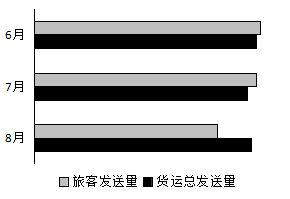
B.
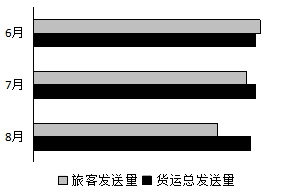
C.
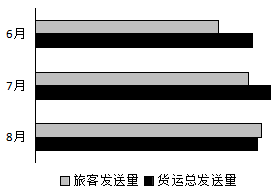
D.
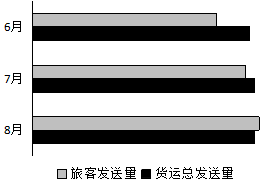
第 62 题
单选题
表1 2018年6月全国铁路主要指标完成情况

表2 2018年7月全国铁路主要指标完成情况

表3 2018年8月全国铁路主要指标完成情况

截至2017年8月,全国铁路货运总周转量当年累计完成约( )亿吨公里。

表2 2018年7月全国铁路主要指标完成情况

表3 2018年8月全国铁路主要指标完成情况

截至2017年8月,全国铁路货运总周转量当年累计完成约( )亿吨公里。
A.
19 885
B.
17 631
C.
9 447
D.
244 360
第 63 题
单选题
表1 2018年6月全国铁路主要指标完成情况

表2 2018年7月全国铁路主要指标完成情况

表3 2018年8月全国铁路主要指标完成情况

以下说法正确的有( )。
(1)2018年6—8月全国铁路旅客周转量合计超过4 000亿人公里
(2)截至2018年7月铁路固定资产投资当年累计完成额高于2017年同期
(3)2018年6—8月全国铁路货运总周转量呈现上升趋势
(4)2017年上半年全国铁路旅客发送量当年累计超过15亿人

表2 2018年7月全国铁路主要指标完成情况

表3 2018年8月全国铁路主要指标完成情况

以下说法正确的有( )。
(1)2018年6—8月全国铁路旅客周转量合计超过4 000亿人公里
(2)截至2018年7月铁路固定资产投资当年累计完成额高于2017年同期
(3)2018年6—8月全国铁路货运总周转量呈现上升趋势
(4)2017年上半年全国铁路旅客发送量当年累计超过15亿人
A.
1个
B.
0个
C.
2个
D.
3个
第 64 题
单选题
近期,“座霸”现象成为大家议论的话题。在我们的社会生活中有许多规定,如“乘车规定”、“考场规则”、“游园规则”等,每位公民都必须自觉遵守这些规定,原因在于:
A.
良好的秩序会限制人们的自由
B.
社会生活离不开共同的准则
C.
道德比法律更具约束力
D.
这些规定都有国家强制力保证实施
第 65 题
单选题
2018年8月,江苏昆山的一起街头案件引发了全社会的关注。开车的刘某持刀威胁骑电动车的于某,不想刀子掉落地上,被于某捡起后反捅几刀,最后致使刘某死亡,这起案件引发了网友对正当防卫和防卫过当的热烈讨论。关于正当防卫,下列表述不正确的是:
A.
对正在进行的严重危及人身安全的暴力犯罪采取防卫行为,造成不法侵害人重伤、死亡的,不属于防卫过当,不负刑事责任
B.
正当防卫与防卫过当区别的关键在于是否明显超过必要限度造成重大损害
C.
在特殊情况下,对已经结束的侵害也可以正当防卫
D.
正当防卫的起因条件是有不法侵害行为发生
第 66 题
单选题
范冰冰偷逃税案件落定,相关单位与人员被一一问责,依法纳税是公民的基本义务,下列对“纳税人”的理解,不正确的是:
A.
纳税人是由税法和企业或个人所处的经济地位决定的
B.
纳税人包括所有法人和自然人
C.
不同的税种有不同的纳税人
D.
只要负有直接纳税的义务,就是纳税人
第 67 题
单选题
习近平总书记把中国人民的伟大民族精神具体阐述为伟大创造精神、伟大奋斗精神、伟大团结精神、伟大梦想精神这四种精神。下列古语涵义与之对应恰当的是:
A.
发愤忘食,乐以忘忧,不知老之将至云尔(孔子)——奋斗精神
B.
上善若水,水善利万物而不争(老子)——梦想精神
C.
穷则独善其身,达则兼善天下(孟子)——创造精神
D.
政之所兴在顺民心,政之所废在逆民心(管子)——团结精神
第 68 题
单选题
即使在个人独处、无人监督时,也要坚守自己的道德信念,对自己的言行小心谨慎,不做任何不道德的事。这说的是我们每个人在进行自我修养时,应该:
A.
闭门造车,坐而论道
B.
坚持“慎独",纯洁品质
C.
虚心求教,勤于积累
D.
学习榜样,积极进取
第 69 题
单选题
王某在甲银行工作,陈某在乙银行工作,两人是多年好友,陈某向王某提议分享彼此的客户资源,以最大化各自的销售业绩,以拿到更丰厚的提成。此时,王某正确的做法应是( )。
A.
给陈某客户信息可以,但是不能把详细信息给陈某
B.
告诉陈某这样的行为严重违反了法律、法规和银行的规定,坚决拒绝
C.
这是一个互利双赢的好办法,可以应允
D.
大家都是朋友,就算帮忙也要答应
第 70 题
单选题
经党中央批准、国务院批复,自2018年起,将每年农历________设立为“中国农民丰收节”,这是第一个在国家层面专门为农民设立的节日。
A.
芒种
B.
秋分
C.
立秋
D.
白露
第 71 题
单选题
2018年,中国迎来改革开放40周年。习近平总书记指出,中国坚持改革开放不动摇。中国越发展,就越开放,中国开放的大门不可能关闭。改革开放永无止境,只有进行时,没有完成时,这是因为:
A.
解放和发展生产力,必须坚持改革开放
B.
改革开放是强国之路、立国之本
C.
改革开放将从根本上改变我国的经济政治体制和社会基本制度
D.
改革开放将消除我国发生金融危机的风险
第 72 题
单选题
根据2018年政府预算报告和预算草案,2017年全国一般公共预算收入扭转了2012年以来增速放缓态势。2018年,我国一般公共预算收入将超过18万亿元,支出接近21万亿元,赤字规模与去年持平,赤字率比2017年预算降低0.4个百分点。
以下对这组数字的理解,有误的一项是:
以下对这组数字的理解,有误的一项是:
A.
全国一般公共预算收入扭转增速放缓态势,印证了我国经济发展不仅总量扩大,而且质量和效益提升
B.
调低赤字率,主要是我国经济稳中向好、财政增收有基础,也为宏观调控留下更多政策空间
C.
赤字总规模并未减小,彰显积极财政政策更加聚力增效的新特点,更侧重在减费降税扩投资方面发力
D.
当前财政状况出现好转,各级政府仍要坚持过紧日子,执守简朴、力戒浮华,严控一般性支出,把宝贵的资金更多用于为发展增添后劲、为民生雪中送炭
第 73 题
单选题
2017年12月召开的中央经济工作会议指出,中国特色社会主义进入了新时代,我国经济发展也进入了新时代,基本特征就是我国经济已由:
A.
虚拟经济转向实体经济
B.
不均衡发展阶段转向协调发展阶段
C.
高速增长阶段转向高质量发展阶段
D.
传统经济转向现代经济
第 74 题
多选题
“任何公民享有宪法和法律规定的权利,同时必须履行宪法和法律规定的义务”。下列关于权利与义务的说法错误的有:
第 75 题
多选题
第22届“中国青年五四奖章”揭晓。获奖的青年,有的在科技前沿攻关,有的在基层锻炼成长,有的在创业一线打拼。不一样的人生经历,同样的令人感动,他们组成了新时代新青年的奋斗群英谱,这给我们青年的人生启示有:
A.
人生价值的实现过程就是施展才能的个人奋斗过程
B.
要把个人价值选择与祖国的前途命运紧密结合
C.
要坚定理想信念,通过砥砺自我这一根本途径创造价值
D.
要在服务社会的青春奋斗历程中实现人生价值
第 76 题
多选题
作为银行从业人员坚持依法合规,以下做法中正确的有( )。
A.
严格遵守各项法律、法规,自觉抵制种法违规行为,维护国利法和金融安全
B.
履行法律义务,保守国家机密和商业秘密
C.
根据银行内部交易流程及岗位职责管理规定,保管好印章,重要凭证等与自身职责有关的物品
D.
妥善保管或销毁填有客户信的单据,凭证、开户申请书或交易指令
第 77 题
多选题
2018年,国务院总理李克强在做政府工作报告时表示,坚决打好三大攻坚战。三大攻坚战是指:
第 78 题
多选题
2018年修改后的个人所得税法将个税起征点由3500元/月提高至6万元/年,优化调税税率结构,对四项劳动性质所得实行综合征税,同时设立专项附加扣除,新一轮个税改革的意义在于:
A.
调高免征额,最大程度降低人民的税收负担
B.
扩大个人所得税征税对象的范围
C.
进一步发挥个人所得税调节社会收入分配、促进社会公平的作用
D.
有利于减轻个人负担,增加居民收入,增强消费能力
第 79 题
单选题
由表中数据可推断出( )

Ⅰ、我国经济发展的协调性在不断增强
Ⅱ、我国推进“中国制造”向“中国创造”转变
Ⅲ、第一产业在我国经济中的地位下降
Ⅳ、我国产业结构在不断优化升级

Ⅰ、我国经济发展的协调性在不断增强
Ⅱ、我国推进“中国制造”向“中国创造”转变
Ⅲ、第一产业在我国经济中的地位下降
Ⅳ、我国产业结构在不断优化升级
A.
Ⅰ 和 Ⅳ
B.
Ⅰ 和 Ⅱ
C.
Ⅱ 和 Ⅲ
D.
Ⅲ 和 Ⅳ
第 80 题
单选题
近期,我国物价总水平保持平稳运行态势。下列指标中,不属于衡量通货膨胀水平常用指标的是( )。
A.
国民生产总值物价平减指数
B.
国内生产总值物价平减指数
C.
生产者物价指数
D.
消费者物价指数
第 81 题
单选题
在线差旅、交通出行、网络购物等诸多网络平台企业纷纷被曝出可能存在大数据“杀熟”行为——购买同样的产品或服务,老客户反面要比新客户花钱更多。针对网络平台企业的“杀熟”行为,以下说法正确的是( )。
A.
这是二级价格歧视在互联网经济中的运用,利用了新老客户需求价格弹性不同
B.
这是二级价格歧视在互联网经济中的运用,利用了新老客户收入价格弹性不同
C.
这是一级价格歧视在互联网经济中的运用,利用了新老客户收入价格弹性不同
D.
这是一级价格歧视在互联网经济中的运用,利用了新老客户需求价格弹性不同
第 82 题
单选题
居民人均可支配收入,通常指家庭总收入扣除个人缴纳的个人所得税及社会保障支出后的收入水平。下列经济指标中,会对居民人均可支配收入产生最直接影响的是( )。
A.
恩格尔系数
B.
基尼系数
C.
国内生产总值
D.
居民消费价格指数
第 83 题
问答题
为践行“绿水青山就是金山银行”的理念,我国加大环境保护治理力量,从2018年开始征收环境保护税,若甲公司生产的产品被征收较高的环境保护税,假定其他条件不变,由此引起的市场变化是( )。
第 84 题
单选题
2018年以来,银行理财资金主要投向债券、存款、货币市场工具等标准化资产,占比约为70%。从理论上分析,一般而言,货币市场工具的特点不包括( )。
A.
对利率敏感
B.
单一化投资
C.
流动性强
D.
期限短
第 85 题
单选题
《财政蓝皮书:中国财政政策报告(2018)》显示,从“积极”到“积极有效”,是2017年以来我国财政政策呈现的新特征。下列经济政策中,不属于财政政策的是( )。
A.
预算政策
B.
利率政策
C.
税收政策
D.
支出政策
第 86 题
单选题
债券利率是政府、银行以及企业等在金融市场上以发行债券的方式筹措资金,对债券购买者所支付的利率。对于债券利率的风险结构,下列说法错误的是( )。
A.
债券流动性越强,利率越高
B.
在同等条件下,具有免税特征的债券利率要低
C.
债券利率的风险结构受多种因素影响,一般由违约风险、流动性和所得税因素三个原因引起
D.
债券违约风险越大,利率越高
第 87 题
单选题
2018年9月10日,新一轮储蓄国债开始发售。我国发行国债的根本目的是( )。
A.
筹集建设资金
B.
抑制社会消费
C.
调控经济发展状况
D.
弥补财政赤字
第 88 题
单选题
我国金融衍生品市场作为新生事物历经了20多年的发展,逐步进入健康稳定发展、经济功能日渐显现的良性轨道。关于金融衍生品,下列说法错误的是( )。
A.
金融衍生品具有杠杆性、联动性、高风险性及跨期性等特征
B.
金融衍生品的基础变量种类繁多,主要包括利率、汇率、价格指数、各类资产价格等
C.
金融衍生品合约中需载明交易品种、价格、数量、交割时间及地点等
D.
金融衍生品又称金融衍生工具,其价格决定基础金融产品的价格
第 89 题
单选题
2018年以来,中国人民银行坚持稳健中性的货币政策,前瞻性预调微调,在推动经济高质量发展中发挥重要作用,以下关于货币政策工具的说法正确的是( )。
A.
货币政策工具主要包括法定存款准备金、再贴现和公开市场业务等
B.
短期流动性调节工具属于再贴现政策范畴
C.
中期借贷便利属于再贴现政策范畴
D.
央行实施再贴现政策具有一定主动性,受商业银行的影响较小
第 90 题
单选题
随着经济发展阶段的新变化,货币供给机制需要与经济增长阶段转换相匹配。在货币供给机制中,中央银行和商业银行具备的功能是( )。
A.
中央银行和商业银行都具备信用创造货币的功能
B.
中央银行和商业银行都具备创造派生存款的功能
C.
中央银行具备创造派生存款的功能,商业银行具备信用创造货币的功能
D.
中央银行具备信用创造货币的功能,商业银行具备创造派生存款的功能
第 91 题
单选题
中国银行保险监督管理委员会发布2018年二季度银行业主要监督指标数据。以下哪项数据体现了商业银行的风险抵补能力?( )
A.
存贷款比例为72.30%,较上季末上升1.13个百分点
B.
平均资产利润率1.03%,较上季末下降0.02个百分点
C.
核心一级资本充足率为10.65%,较上季末下降0.06个百分点
D.
正常贷款余额103.1万亿元,其中正常类贷款余额99.6万亿元
第 92 题
单选题
根据商业银行战略与财务预算之间的关系,将相应内容依次填入下图正确的是( )。
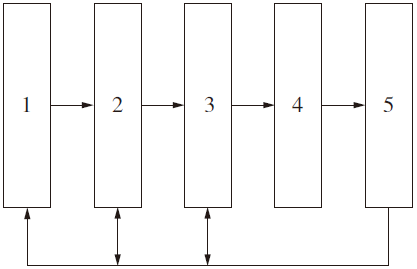

A.
1-商业银行战略愿景,2-商业银行战略目标,3-商业银行预算目标,4-预算编制与执行监控,5-预算反馈与考核评估
B.
1-商业银行预算目标,2-商业银行战略目标,3-商业银行战略愿景,4-预算编制与执行监控,5-预算反馈与考核评估
C.
1-商业银行战略目标,2-商业银行战略愿景,3-商业银行预算目标,4-预算编制与执行监控,5-预算反馈与考核评估
D.
1-商业银行预算目标,2-商业银行战略愿景,3-商业银行战略目标,4-预算编制与执行监控,5-预算反馈与考核评估
第 93 题
单选题
根据银保监会公布的数据,2018年上半年,商业银行不良贷款率为1.86%,在商业银行贷款的五级分类中属于不良贷款的是( )。
A.
关注贷款,次级贷款,损失贷款
B.
关注贷款、可疑贷款、损失贷款
C.
次级贷款、可疑贷款、损失贷款
D.
关注贷款、可疑贷款、次级贷款
第 94 题
单选题
贷前调查是银行信贷业务的重要风险防线。在贷前调查中,客户的涉外报表是银行了解客户的重要工具。客户经理赵小平在走访某目标客户时,获得该公司2017年资产负债表(简表)相关信息如下:
资产负债表(2017年12月31日) 单位:百万元

补充资料:
(1)长期借款与所有者权益之比0.2
(2)营业成本与营业收入比率:80%
(3)存货周转率(存货按年末数计算):10次
(4)应收账款周转天数(按营业收入和应收账款年末数计算,不考虑应收票据):18.25天
(5)总资产周转率(总资产按年末数计算):3次
根据资产负债表(简表)及补充资料,可测算出该公司的资产负债率为( )。
资产负债表(2017年12月31日) 单位:百万元

补充资料:
(1)长期借款与所有者权益之比0.2
(2)营业成本与营业收入比率:80%
(3)存货周转率(存货按年末数计算):10次
(4)应收账款周转天数(按营业收入和应收账款年末数计算,不考虑应收票据):18.25天
(5)总资产周转率(总资产按年末数计算):3次
根据资产负债表(简表)及补充资料,可测算出该公司的资产负债率为( )。
A.
52.5%
B.
37.5%
C.
45%
D.
60%
第 95 题
单选题
贷前调查是银行信贷业务的重要风险防线。在贷前调查中,客户的涉外报表是银行了解客户的重要工具。客户经理赵小平在走访某目标客户时,获得该公司2017年资产负债表(简表)相关信息如下:
资产负债表(2017年12月31日) 单位:百万元

补充资料:
(1)长期借款与所有者权益之比0.2
(2)营业成本与营业收入比率:80%
(3)存货周转率(存货按年末数计算):10次
(4)应收账款周转天数(按营业收入和应收账款年末数计算,不考虑应收票据):18.25天
(5)总资产周转率(总资产按年末数计算):3次
根据上述资料,可测算出该公司2017年的营业收入为( )。
资产负债表(2017年12月31日) 单位:百万元

补充资料:
(1)长期借款与所有者权益之比0.2
(2)营业成本与营业收入比率:80%
(3)存货周转率(存货按年末数计算):10次
(4)应收账款周转天数(按营业收入和应收账款年末数计算,不考虑应收票据):18.25天
(5)总资产周转率(总资产按年末数计算):3次
根据上述资料,可测算出该公司2017年的营业收入为( )。
A.
2 400百万元
B.
1 800百万元
C.
900百万元
D.
1 500百万元
第 96 题
单选题
通力机械是一家以加工模具为主营的企业,近三年年销售收入保持在9 000万元左右。2017年,该企业在建设银行开设了基本结算账户,目前在建设银行有1 000万元流动资金贷款,客户经理李明在对该企业进行维护的过程中发现,该企业的现金周转天数连续三年呈上升趋势,为缩短该企业的现金周转期,李明可以给该企业的建议是( )。
A.
利用商业信用,延迟支付货款
B.
向银行申请流动资金贷款
C.
转让以前的对外投资
D.
加快制造和销售
第 97 题
单选题
甲、乙两家公司同为医疗器械企业,某银行公司客户经理在进行贷前调查时发现两家公司的财务指标如下:
甲公司相关财务指标

乙公司相关财务指标

对于甲、乙两家公司在经营战略和财务政策上的差别,下列选项中表述正确的是( )。
甲公司相关财务指标
乙公司相关财务指标
对于甲、乙两家公司在经营战略和财务政策上的差别,下列选项中表述正确的是( )。
A.
在经营政策上,从指标来看,乙公司的盈利能力和营运能力都高于甲公司 B在经营政策上,从指标来看,甲公司的盈利能力和营运能力都高于乙公司 C.在经营政策上,甲公司采用的是“低盈利、高周转”方针,乙公司采用的是“高盈利、低周转”的方针;在财务政策上,甲公司配置的财务杠杆高 D.在经营政策上,甲公司采用的是“低盈利、高周转”方针,乙公司采用的是“高盈利、低周转”的方针;在财务政策上,乙公司配置的财务杠杆高
B.
在经营政策上,甲公司采用的是“低盈利、高周转”方针,乙公司采用的是“高盈利、低周转”的方针;在财务政策上,甲公司配置的财务杠杆高
C.
在经营政策上,甲公司采用的是“低盈利、高周转”方针,乙公司采用的是“高盈利、低周转”的方针;在财务政策上,乙公司配置的财务杠杆高
第 98 题
单选题
银行发放贷款有严格的审查程序和制度,在发放贷款前应对抵押物及时办理抵押登记以减少贷款风险,下列用于抵押的财产中,进行抵押登记后抵押权才能生效的是:
A.
建设用地所有权
B.
交通运输工具
C.
生产设备和原材料
D.
正在建造的建筑物
第 99 题
单选题
甲公司是一张6个月以后到期的银行承兑汇票所记载的收款人,后甲公司由于业务发展需要,和乙公司合并为丙公司,丙公司于上述票据到期时向承兑人提示付款,下列表述中,正确的是:
A.
甲公司和乙公司共同背书后,丙公司才能取得票据权利
B.
甲公司背书后,丙公司才能取得票据权利
C.
丙公司不能取得票据权利
D.
丙公司取得票据权利
第 100 题
单选题
多年来,星巴克坚持直营经营,严格要求经营者认同公司的理念,认同品牌,强调动作、纪律和产品品质的一致性,对咖啡店、牛奶等原材料的使用都有着严格的标准规定,这体现了下列哪项管理职能?
A.
控制
B.
领导
C.
组织
D.
计划
第 101 题
单选题
管理者很多时候就想一粒火种,当要点燃组织并给予组织正能量时,需借助一个正当渠道,但往往比较慢热。如果管理者有一个不当行为传递出负能量时,它往往会先点燃一个非正式组织,而且会烧的很彻底,让非正式组织的每一个成员都深深的浸染在负能量之中,然后它会迅速的向其他非正式组织传递,下列关于非正式组织的说法中,错误的是:
A.
非正式组织的压力会抵制正式组织的变革,刺激组织成品产生抵制革新的心理,增强组织的惰性,管理者应当充分了解其价值观和诉求
B.
非正式组织满足了成员情感抒发的需求,管理者应当重视组织中非正式组织的影响力,尊重员工的各种情感需求,使其感到充分的理解和尊重
C.
非正式组织要求成员一致性的压力,往往会束缚成员的个人发展,个别成员的努力工作会引起非正式组织成员的反感和抵触,管理者应当尽可能分化瓦解非正式组织
D.
非正式组织的影响力对管理者会造成一定压力进而产生制衡作用,因此,管理者在做计划与决策时需重视非正式组织的存在
第 102 题
单选题
甲作为某银行的网点负责人,具有自身明显的领导风格,在管理员工时注重正式组织结构和规章制度的作用,在做经营决策时也重视让员工参与决策过程,则甲的领导类型是:
A.
独断型
B.
放任型
C.
保守型
D.
民主型
第 103 题
单选题
微笑服务是银行网点十分重视的一项服务细节,然而,柜员小李却常因为态度不佳,收到客户投诉网点负责人设计了一项“最美微笑”评选活动,让客户和员工每周评选出服务中的最美微笑,并将微笑图片在网点内展示。小李一次偶然的微笑服务,被拍下并获得当周的“最美微笑”,网点负责人通过及时的物质奖励以及赠送鲜花等方式认可了她的表现。此后,小李的微笑服务次数逐渐变多,服务水平大为改观,可见,该网点负责人有效运用了以下哪种激励理论?
A.
公平理论
B.
期望理论
C.
强化理论
D.
目标设置理论
第 104 题
单选题
随着移动互联网信息技术的运用以及新生代消费群体的变迁,年轻人的需求不再局限于企业所提供的单一品种规模化流水线上生产的产品。对个性化产品进行定制以满足自身需求已逐渐成为一种消费市场的趋势,从一件衣服到一款家电,都可以实现“个性化定制”,这种消费属于( )。
A.
攀比心理引发的消费
B.
从众心理引发的消费
C.
求异心理引发的消费
D.
求同心理引发的消费
第 105 题
单选题
一项研究表明,92%的消费者对亲朋好友推荐产品的信任程度要远远超过任何形式的广告,于是很多营销者开始在消费者中寻找和培养“意见领袖”,这种方式体现了( )对消费者行为的影响。
A.
社会因素
B.
文化因案
C.
个人因素
D.
心理因素
第 106 题
单选题
银行等金融机构中产生的数据通常相对完整、可靠和高质量,这大大方便了系统化的数据分析和数据挖掘。以下对数据挖掘的说法中,错误的是( )。
A.
一般情况下数据挖掘的过程包括五个步骤,确定业务对象、数据准备、数据挖掘、结果的解释评估、可视化及知识同化
B.
确定要完成的数据挖掘功能后,仅需根据数据的不同特点选择挖掘算法,确定算法后,挖掘系统即可对数据进行分析,实现自动挖掘
C.
数据挖掘是一种商业信息处理技术,其主要特点是对商业数据库中的大量业务数据进行抽取、转化、分析和模式化处理,从中提取辅助性的关键知识
D.
数据挖掘的未来不再是针对少量或是样本化、随机化的精准数据,而是海量、混杂的大数据
第 107 题
单选题
近年来,勒索病毒集中爆发对不少行业造成了很大的威胁,甚至已经造成了不小的损失。关于勒索病毒网络攻击,下列选项表述正确的是( )。
A.
加强内网自主操作系统建设是防范勒索病毒的重要途径
B.
勒索病毒网络攻击是一种简单的网络攻击
C.
只要采取了网络隔离技术就可以防止勒索病毒的攻击
D.
勒索病毒网络攻击不以金钱为目的
第 108 题
单选题
以量子计算、物联网、区块链、大数据为代表的新一代信息技术正在加速突破应用,深刻影响国家的前途命运和人民生活福祉。下列新技术与其特征对应不正确的是( )。
A.
区块链——分布式数据存储、点对点传输、共识机制、加密算法
B.
大数据——海量的数据规模、多样的数据类型、数据价值密度高
C.
量子计算——巨大信息携带量、超强并行计算处理能力
D.
物联网——物与物互连、人与物互连、人与人互连
第 109 题
单选题
某电信公司推出两种手机收费方式,A种方式是月租20元,B种方式是月租0元。一个月的本地网内通话时间t 分钟 与电话费S 元 的函数关系如图所示。

B

A
当通话150分钟时,这两方式的电话费相差( )。

B

A
当通话150分钟时,这两方式的电话费相差( )。
A.
15
B.
20
C.
10
D.
30
第 110 题
单选题
“劳动者港湾”作为建设银行重要的服务品牌,用心温联社会,用爱接力责任,鲜明诠释了建设银行作为国有大行践行( )的发展思想、用金融力量解决社会痛点、建设美好生活的情怀和担当。
A.
客户至上
B.
惠普金融
C.
国家战略与民生需求相结合
D.
以人民为中心
第 111 题
单选题
建设银行“绿树”大数据种子人才培养工程旨在为全行培养更多优秀的大数据分析人才,培训课程包括数据挖掘模型、智统化数据分析工具、金融科技优秀案例等,回归模型的建立方法与步骤是培训的重点内客,根据古典线性回归模型的基本假设,线性回归模型中的解释变里应是非随机变量,且应当( )。
A.
与随机误差项不相关
B.
与残差项不相关
C.
与被解释变量不相关
D.
与回归值不相关
第 112 题
单选题
建设银行某网点整合了机器人、智慧柜员机、VTM机、外汇兑换机、VR、AR、人识识别、语音导航等前沿科技,为客户呈现了一个以智慧、共享、体验、创新为特点的全自功智能服务网点.在网点内,智能机器人取代了银行柜台及工作人员,客户通过身份证,实名认证即可办理各种业务,全程无需银行员工参与办理业务.由上可知,该网点是建设银行推出的全国首家( )。
A.
“轻型银行”
B.
“科技银行”
C.
“智慧银行”
D.
“无人银行”
第 113 题
单选题
某公司从客户名录中陆机抽取1000个客户进行满意度和贡献度调查,为验证总体满意度高的客户更倾向于成为贡献虚高的客户,应采用的统计方法是( )。
A.
参数估计
B.
最小二乘法
C.
假设检验
D.
频数统计
第 114 题
单选题
为了解某城市的职场竞争态势,研究者拟通过2017年该旅市金融行业和快造消费品行业各10000人的样本数据,来比较这两个行业从业人员年薪的离散程度,则其应采用的统计方法是( )。
A.
偏态系数
B.
相关系数
C.
标准分数
D.
变异系数
第 115 题
单选题
如何精准预测共享单车短期需求,从而科学合理地确定单车投放和调度,不仅是企业运营效率问题,也与社会合理使用、城市空间合理布局等问题密切相关。下列关于预测方法及其主要特点描述错误的是( )。


A.
A
B.
B
C.
C
D.
D
第 116 题
单选题
“建行惠懂你”APP的推出是建设银行实施平台经营、数据经营,践行普高金融与金融科技战略,支持( )发展,将银行信贷服务送到客户手中的一项重大创新举措。
A.
小微企业
B.
大中型企业
C.
国有企业
D.
互联网企业
第 117 题
单选题
建设银行主动担当国有大行使命和责任,在同业中率先推出住防租货综合解决方案,搭建集五大系统于一体的住房租货综合服务平台,打造了( )住房租货业务服务品牌。
A.
“要租房 到建行”
B.
“房子是用来住的租挺好”
C.
“CCB善融家园”
D.
“长租即长住,长住即安家”
第 118 题
多选题
2018年,我国GDP发展的预期目标是6.5%左右,增速较往年放缓,经济运行仍面临较大的下行压力。对此,政府要采取积极有力的宏观政策加以应对,下列符合这一要求的政策有:
第 119 题
多选题
经济周期又称商业周期,一般分为衰退、萧条、复苏和繁荣等四个阶段。从理论上分析,下列关于经济周期四阶段的说法正确的有:
A.
在经济复苏阶段,经济表现为总需求日益扩大,过剩产能逐步消化,经济开始从整个周期的谷底向上发展
B.
在经济萧条阶段,经济表现为总需求日益减少,总供给过剩,商品和要素市场存在大量积压
C.
在经济繁荣阶段,虽然经济进一步活跃,但人们的生产热情下降,对未来的信心开始缩减,产能利用率下降
D.
在经济衰退阶段,经济增长已经从周期的波峰开始下降,经济增长率虽然已调整为负,但整体经济发展依然存在惯性上升趋势
第 120 题
多选题
假定其他条件不变,在通常情况下,下列经济行为与曲线所反映的变动关系相符合的有:


A.
Y为科技创新能力,X为经济增长质量,经济现象在B曲线上变动,国民经济持续健康发展
B.
Y为恩格尔系数,X为居民消费水平,经济现象在A曲线上变动,经济一定增长
C.
Y为价格,X为需求量,经济现象在A曲线上变动,相关企业会增加对该商品替代品的生产
D.
Y为风险系数,X为收益率,经济现象在B曲线上变动,投资规模一定扩大
第 121 题
多选题
中国某手机厂商依托技术创新和精品战略转型,自主研发手机芯片等核心部件,生产出功能更强、体验更好、性价比更高的手机,2017年智能手机全年发货1.53亿台,全球份额突破10%,稳居全球前三。该厂商的成功得益于:
A.
个别劳动时间大于社会必要劳动时间,商品价值增加
B.
依托自主创新提高商品的使用价值,扩大商品需求
C.
个别劳动生产率高于社会劳动生产率,获得竞争优势
D.
依托自主开发提高社会劳动生产率,使商品价值增加
第 122 题
多选题
财政部公布数据显示,2017年,全国一般公共预算收入172567亿元,同比增长7.4%,其中:非税收入28207亿元,同比下降6.9%。全国一般公共预算支出203330亿元,同比增长7.7%,其中,社会保障和就业支出24812亿元,增长16%;医疗卫生与计划生育支出14600亿元,增长9.3%;教育支出30259亿元,增长7.8%。下列对此解读正确的有:
A.
政府推进税费改革,清理规范涉企收费,降费措施取得成效
B.
我国财政收支增速都快于经济增速表明财政是经济发展的基础
C.
我国当前实行的是扩张性财政政策,会减少市场的货币流通量
D.
我国更加凸显公共财政的性质,有助于改善民生促进社会公平
第 123 题
多选题
外汇储备是指为了应付国际支付的需要,由一国中央银行及其他政府机构所集中掌握的外汇资产。下面是2017年人民币对美元汇率图和中国外汇储备规模变化图。以下推断正确的有:( )。
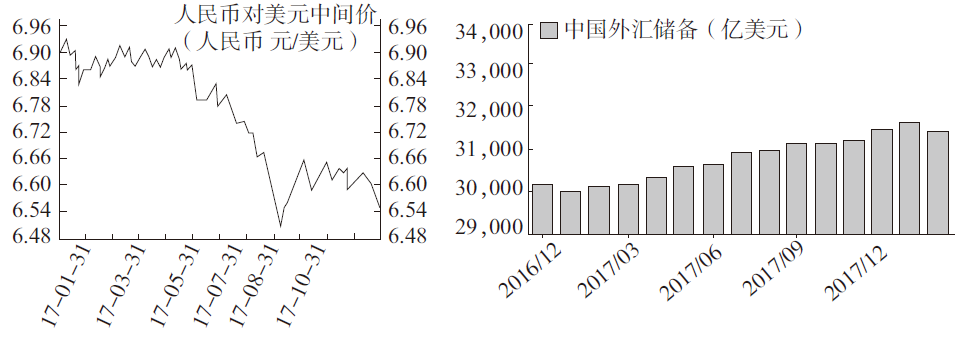

A.
2017年人民币对美元汇率总体上升,有利于我国扩大进口
B.
2017年美元对人民币总体上贬值,导致我国外汇储备中美元资产缩水
C.
2017年我国调节国际收支能力增强,有利于维持外汇市场供求平衡
D.
2017年我国对外贸易结构不断优化,有足够能力有效应对贸易摩擦
第 124 题
多选题
2018年9月27日,美联储货币政策委员会FOMC宣布加息25个基点,将联邦基金目标利率区间上调至2%~2.25%。若不考虑其他因素,下列推导正确的有:( )。
A.
美联储加息→美元走强→人民币贬值→增强中国外向型企业出口优势
B.
美联储加息→美国物价回升→吸引外资注入美国市场→刺激经济增长
C.
美联储加息→倒逼中国供给侧改革→优化产业结构→促进实体经济发展
D.
美联储加息→美元走弱→人民币升值→增强我国企业对外投资优势
第 125 题
多选题
经济资本是银行应该保有的最低资本量,用以衡量和防御银行损失超出预期的部分。以下对于基于信用风险的经济资本计量的说法,错误的有( )。
A.
违约损失率(LGD)是指债务人在实际违约发生前可能给债权人造成的损失
B.
违约风险暴露(EAD)是指债务人违约时的预期表内风险暴露总额
C.
违约概率(PD)是指客户未来一段时间内(一般是一年)发生违约的可能性
D.
经济资本与监管资本都是对风险的估计,两者都是由外部监管机构计算的
第 126 题
多选题
根据巴塞尔协议Ⅲ,以下可以提高银行资本充足率的举措有( )。
第 127 题
多选题
在人民币国际化进程中,要保持我国货币币值基本稳定,必须根据国民经济发展的需要来调节货币流通量。下列措施恰当的有( )。
A.
坚持货币的经济发行,避免财政发行
B.
加强现金管理,合理地限制以货币为流通手段的范围
C.
根据一定时期商品流通的客观需要,有计划地调节货币流通量
D.
把货币的经济发行和财政发行同时并重,不可偏废
第 128 题
多选题
在贷后管理检查中,某银行客户经理小王发现某小企业客户2017年账面净利润很多,但是其偿债能力却出现了风险预警(行内风险预警系统显示该小企业客户可能不能偿还当年到期债务)。为查清原因,小王应重点检查该小企业客户的哪些财务指标( )。
第 129 题
多选题
下列各项中,属于影响企业偿债能力的表外因素的有( )。
第 130 题
多选题
如今,全球5G浪潮兴起。5G技术,即第五代移动通信技术,被认为是未来信息技术的发展方向和战略制高点,也是我国实施“网络强国”“制造强国”战略的重要措施。下列关于5G的说法,正确的有( )。
第 131 题
多选题
王某与他人共同出资设立了一家有限责任公司,王某任法定代表人,后来贵司因经营不善破产,公司资产不足以清偿债务,公司的债权人要求王某偿还不足部分,根据《中华人民共和国公司法》,下列说法错误的有:
A.
王某是公司投资人,公司的债权人可以求王某偿还
B.
王某设立的是有限责任公司,不足的部分不需要再偿还
C.
王某是法定代表人,公司的债权人可以要求王某偿还
D.
王某与他人合作的投资,王某应当按照出资比例对公司的债务承担偿还责任
第 132 题
多选题
下列关于企业盈利能力、营运能力、发展能力和偿债能力的说法,错误的有( )。
A.
企业可以通过提高营业净利率、加速资产周转来提高其净资产收益率
B.
对于银行来说,企业净资产收益率越高,则其偿债能力就越高
C.
只有当营业收入增长率大于1时,才能够说明本年企业的营业收入有所增长
D.
所有者权益增长率越高,说明企业的资本积累越多,企业的抗风险能力越强
第 133 题
多选题
组织文化以其愿景、使命、价值观等核心内容影响着组织的战略发展导向,使组织具备了潜在的巨大凝聚力和向心力。关于组织文化,以下说法正确的有:
A.
所有的组织都有文化,但并不是所有文化都相同程度地影响组织成员的行为和行动
B.
一般而言,组织文化的最初来源通常反映组织创建者的愿景
C.
组织文化是组织成员共有的能够影响其行为方式的价值观、原则、传统和做事方式
D.
在绝大多数组织中,共有的价值观和管理会随着时间的推移而演变
第 134 题
多选题
中国建设银行田国立董事长在《服务大众安居乐业 建设现代美好生活》一文中详细阐述建设银行以“住房租赁、普惠金融、金融科技”为内涵的“三大战略”,展现建设银行通过金融工作解决社会问题的路径及决心。对于战略管理,下列说法正确的有:
A.
SWOT分析是战略管理中一种非常重要的战略分析方法
B.
在战略管理过程中,识别出组织当前的使命,目标和战略是重要的步骤
C.
建设银行“三大战略”属于企业战略
D.
有效的战略会带来组织高绩效
第 135 题
多选题
在现实生活中,合同一经成立就具有了法律效力,合同涉及的当事人双方必须按照合同所约定的内容来履行,否则就要承担违约责任。根据《中华人民共和国合同法》,违约责任的承担方式包括:
第 136 题
多选题
大数据风控是指在申请、审核、放款、贷后各环节中利用如黑名单、消费记录、行为数据、社交网络数据、搜索引擎、信用数据等各种数据,通过逻辑回归,决策树分析、神经网络建立风控模型,从而实现审批和审核决策的自动化。下列关于大数据风控的说法,正确的有( )。
A.
大数据风控需要具备风控意识和数据意识,同时需要经济学、金融学、心理学、信息技术等方面的专业知识
B.
有了大数据风控就不再需要其他的信贷风控方法了
C.
大数据风控是实时审批、无感知审批的模式,这就要求从申请信息获取开始到最终给出审批结论都需要系统的支持来完成,相应的人工介入的机会比较少,但这并不代表没有人工介入
D.
在进行大数据风控时如果过于在意算法和模型而忽视了数据源、数据预处理,不重视相关的解释而形成“黑箱”,会使在应用模型的过程中风险大增
第 137 题
多选题
下列统计处理中,属于描述统计的有( )。
A.
将某银行男女员工人数比例用饼图呈现
B.
利用折线图展示制造业采购经理指数 PMI 近一年的走势
C.
利用1%的人口抽样调查数据推估年末总人口
D.
利用抽样调查数据估计城镇居民人均消费支出水平
第 138 题
多选题
2017年高铁密度和国内旅游收入的散点图如下:


高铁密度(公里/万平方公里)
国内旅游收入︵亿元︶

根据上图,高铁密度和国内旅游收入两个变量之间的相关关系是( )。


高铁密度(公里/万平方公里)
国内旅游收入︵亿元︶

根据上图,高铁密度和国内旅游收入两个变量之间的相关关系是( )。
第 139 题
多选题
建设银行某员工基于实际业务流程,运用贝叶斯网络对建设银行对建设银行操作风险的量化和控制进行实证研究,在进行贝叶斯统计推断时需使用的信息有( )。
第 140 题
多选题
近年来,中国建设银行持续推进企业社会责任战略,为建设美好生活贡献力量,具体表现在( )。
A.
始终把服务实体经济作为天职和宗旨,倾力服务国家战略,为国家重大项目提供优质高效的综合化金融服务
B.
坚持打造绿色银行,大力推进绿色信贷战略实施,助力国家生态文明建设
C.
继续推进“母亲健康快车”、高中生成长计划、建行希望小学、贫困英模母亲计划等长期公益项目
D.
扎实开展金融精准扶贫,支持贫困地区建设
第 141 题
多选题
近年来,在经济新常态和金融市场新背景下,银行产品和服务进入升级换挡期,对金融消费者权益保护工作提出了更高要求,以下能体现建设提行切实维护消费者合法权益的有( )。
A.
设立《绿色、社会及可持续发展债务框架》 ,展示了相关债券资金募集和管理、项目评估和筛选等事项的规范流程,涵着了绿色信贷、小微企业贷款和农村基础设施建设贷款等内容
B.
制定《客户投诉管理办法》,重新梳理了客户投诉分类,充实、细化了投诉处理流程,并就客户投诉渠道公示、投诉资源运用、客户信息保密等方面作出了具件规定
C.
制定《中国建设银行消费者权益保护工作指引》,将八项消费者合法权益全面融入行为准则,并对各部门在消费者权益保护工作上的职责分工和工作内容等作出了细化规定
D.
制定《消费者权益保护工作考核评价办法》,明确了消费者权益保护工作的考评对象、考评原则、考评指标、考评流程和结果应用等内容
第 142 题
多选题
建设银行“金融科技”战略,以“新一代”核心业务系统为抓手,以共享的理念整合资源,以科技的力量造福大众,以金融的智慧回馈社会,引领面向未来的“新金融”服务模式,以下对建设银行金融科技相关信息的描述,正确的有( )。
A.
建设银行提出“金融科技”战略,积极借助大数据和“互联网+”等新技术新手段,开展产品与服务模式创新,支持实体经济发展
B.
2017年,建设银行历时六年的“新一代”核心系统全面竣工,建成国内银行业规模最大的私有云和国际领先的航母级信息技术平台,在金融科技发展新阶段拥有了先发优势
C.
2018年4月,作为国有大行成立的首家银行系金融科技公司,建信金融科技有限责任公司在上海揭牌
D.
2018年8月,2018中国银行业发展论坛暨第六届银行综合评选颁奖典礼在北京举行,中国建设银行获年度“最具创新金融科技银行”奖项
第 143 题
单选题
According to the text, which of the following statements regarding Tik Tok is true
A.
Tik Tok is also a short-video mobile app only facing the users in Europe.
B.
Tik Tok is beating Tencent’s short-video app, Kuaishou.
C.
Tik Tok is an international version of Douyin.
D.
Both Douyin and Tik Tok are losing their users due to the argument with Tencent.
第 144 题
单选题
What could be an evidence supporting that “WeChat has hardly lost its oomph”
A.
WeChat made up 34% of China’s total mobile-data traffic in 2017, reported by a state agency.
B.
Douyin doesn’t need WeChat at all for advertising.
C.
The share of time spent by Chinese mobile users on messaging slipped from 37% to 32% in the year.
D.
WeChat has already bought up several Bytedance apps.
第 145 题
单选题
Why does the author describe at the beginning of the article that the spat between Douyin and Tencent is like a “teenage dance-off”
A.
Tencent and Douyin both asked their employees to break off possible communications with the other company.
B.
Both Tencent and Douyin make statements to denounce each other’s action.
C.
Tencent blocked its users from registering on Douyin through WeChat account.
D.
Douyin wanted to take the full responsibilities in the argument, while Tencent still accused Douyin’s act as an affectation.
第 146 题
单选题
How long has Weishi, the Tencent product, been closed before it was resuscitated
A.
Half a year.
B.
Three months.
C.
One month.
D.
One year.
第 147 题
单选题
Which one of the following is included in the essay “Tencent Doesn’t Have a Dream”
A.
The reason why Tencent is arguing with Douyin app is that Tencent doesn’t have a dream.
B.
Tencent tended to buy up other startups for investment purposes and had lost its innovative edge.
C.
Tencent blocks young people from chasing their dreams.
D.
The only product that had carried Tencent’s dream is its Weishi; however, Weishi was closed for a significantly long time.
第 148 题
单选题
Jimmy Zhong is a Beijinger who speaks English with an American accent and wears a baseball cap. He recalls the heady days of life in Manhattan after finishing his degree in maths and computer science at Emory University in Atlanta, Georgixuanxiang_tag_enameA. By then he was already rich, having sold his first company — an online marketplace enabling students to sell class notes — for $40m. He was in New York to help build another Internet startup which he had co-founded during his third year at university — a forum for students to buy tutorial help. The money was rolling in.
In early 2017, missing home, he went to spend the lunar-new-year holiday in Beijing. He had heard about the opportunities there, about startup companies such as the bike-sharing firms Ofo and Mobike that had grown into billion-dollar businesses in just a couple of years. “I realized, what am I doing in New York City It’s a complete waste of time.”
And so began his new ventures. One is a Beijing-based startup, Dora, that deals in self-service kiosks such as photo booths. Mr. Zhong says it already has 300 employees and is worth $100m. He is now focusing on another one, IOST, based in Singapore, which is developing software involving block chain, the cryptographic technology behind bitcoin. China recognizes the huge market potential for the underlying technology as an enabler of secure transactions. As in other digital domains, such as artificial intelligence, China is sparing no effort to establish itself as a world leader, so the government badly wants more people like Mr. Zhong to return.
They are doing so in droves, many of them drawn back to China by a boom in tech-related business. In 2016 more than 430,000 people went back to China after finishing their studies, nearly 60% more than in 2011. China’s official news agency, Xinhua, called this one of the biggest return flows of talent in any country’s history: the “magnetic effect” of China’s rise as a global power. About one-sixth of “sea turtles”, as returnees are jokingly known in Chinese, take up IT-related work, according to a survey published last year by the Centre for China and Globalization CCG , a think-tank in Beijing, and Zhaopin, a job-search website. Most of the 150 or so Chinese companies listed on NASDAQ were launched by returnees.
Officials have also offered them generous allowances, housing, health care and other benefits to move back to China. Today’s world not only has the West’s American dream but the East’s Chinese dream as well.
Officials say about 80% of Chinese students now return after finishing their studies, compared with less than one-third in 2006. Some, known as “seagulls”, flit back and forth between East and West. But the trend is clear.
The success of China’s plan to create world leaders in cutting-edge industries, known as “Made in China 2025”, will need returnees. And indeed they make up nearly half of the “core talents” involved in developing artificial intelligence in China, according to ChinaHR.com, a recruitment website. Growing numbers of them have not only been educated in America but have also gained crucial experience there.
What is the main idea of this passage
In early 2017, missing home, he went to spend the lunar-new-year holiday in Beijing. He had heard about the opportunities there, about startup companies such as the bike-sharing firms Ofo and Mobike that had grown into billion-dollar businesses in just a couple of years. “I realized, what am I doing in New York City It’s a complete waste of time.”
And so began his new ventures. One is a Beijing-based startup, Dora, that deals in self-service kiosks such as photo booths. Mr. Zhong says it already has 300 employees and is worth $100m. He is now focusing on another one, IOST, based in Singapore, which is developing software involving block chain, the cryptographic technology behind bitcoin. China recognizes the huge market potential for the underlying technology as an enabler of secure transactions. As in other digital domains, such as artificial intelligence, China is sparing no effort to establish itself as a world leader, so the government badly wants more people like Mr. Zhong to return.
They are doing so in droves, many of them drawn back to China by a boom in tech-related business. In 2016 more than 430,000 people went back to China after finishing their studies, nearly 60% more than in 2011. China’s official news agency, Xinhua, called this one of the biggest return flows of talent in any country’s history: the “magnetic effect” of China’s rise as a global power. About one-sixth of “sea turtles”, as returnees are jokingly known in Chinese, take up IT-related work, according to a survey published last year by the Centre for China and Globalization CCG , a think-tank in Beijing, and Zhaopin, a job-search website. Most of the 150 or so Chinese companies listed on NASDAQ were launched by returnees.
Officials have also offered them generous allowances, housing, health care and other benefits to move back to China. Today’s world not only has the West’s American dream but the East’s Chinese dream as well.
Officials say about 80% of Chinese students now return after finishing their studies, compared with less than one-third in 2006. Some, known as “seagulls”, flit back and forth between East and West. But the trend is clear.
The success of China’s plan to create world leaders in cutting-edge industries, known as “Made in China 2025”, will need returnees. And indeed they make up nearly half of the “core talents” involved in developing artificial intelligence in China, according to ChinaHR.com, a recruitment website. Growing numbers of them have not only been educated in America but have also gained crucial experience there.
What is the main idea of this passage
A.
China is the incubator of the startup companies.
B.
America is no longer appealing to Chinese people.
C.
China will take the lead in some cutting-edge industries.
D.
Growing numbers of Chinese are heading back home after studying abroad.
第 149 题
单选题
Jimmy Zhong is a Beijinger who speaks English with an American accent and wears a baseball cap. He recalls the heady days of life in Manhattan after finishing his degree in maths and computer science at Emory University in Atlanta, Georgixuanxiang_tag_enameA. By then he was already rich, having sold his first company — an online marketplace enabling students to sell class notes — for $40m. He was in New York to help build another Internet startup which he had co-founded during his third year at university — a forum for students to buy tutorial help. The money was rolling in.
In early 2017, missing home, he went to spend the lunar-new-year holiday in Beijing. He had heard about the opportunities there, about startup companies such as the bike-sharing firms Ofo and Mobike that had grown into billion-dollar businesses in just a couple of years. “I realized, what am I doing in New York City It’s a complete waste of time.”
And so began his new ventures. One is a Beijing-based startup, Dora, that deals in self-service kiosks such as photo booths. Mr. Zhong says it already has 300 employees and is worth $100m. He is now focusing on another one, IOST, based in Singapore, which is developing software involving block chain, the cryptographic technology behind bitcoin. China recognizes the huge market potential for the underlying technology as an enabler of secure transactions. As in other digital domains, such as artificial intelligence, China is sparing no effort to establish itself as a world leader, so the government badly wants more people like Mr. Zhong to return.
They are doing so in droves, many of them drawn back to China by a boom in tech-related business. In 2016 more than 430,000 people went back to China after finishing their studies, nearly 60% more than in 2011. China’s official news agency, Xinhua, called this one of the biggest return flows of talent in any country’s history: the “magnetic effect” of China’s rise as a global power. About one-sixth of “sea turtles”, as returnees are jokingly known in Chinese, take up IT-related work, according to a survey published last year by the Centre for China and Globalization CCG , a think-tank in Beijing, and Zhaopin, a job-search website. Most of the 150 or so Chinese companies listed on NASDAQ were launched by returnees.
Officials have also offered them generous allowances, housing, health care and other benefits to move back to China. Today’s world not only has the West’s American dream but the East’s Chinese dream as well.
Officials say about 80% of Chinese students now return after finishing their studies, compared with less than one-third in 2006. Some, known as “seagulls”, flit back and forth between East and West. But the trend is clear.
The success of China’s plan to create world leaders in cutting-edge industries, known as “Made in China 2025”, will need returnees. And indeed they make up nearly half of the “core talents” involved in developing artificial intelligence in China, according to ChinaHR.com, a recruitment website. Growing numbers of them have not only been educated in America but have also gained crucial experience there.
About Jimmy Zhong’s ventures for startup companies, which one of the following is true
In early 2017, missing home, he went to spend the lunar-new-year holiday in Beijing. He had heard about the opportunities there, about startup companies such as the bike-sharing firms Ofo and Mobike that had grown into billion-dollar businesses in just a couple of years. “I realized, what am I doing in New York City It’s a complete waste of time.”
And so began his new ventures. One is a Beijing-based startup, Dora, that deals in self-service kiosks such as photo booths. Mr. Zhong says it already has 300 employees and is worth $100m. He is now focusing on another one, IOST, based in Singapore, which is developing software involving block chain, the cryptographic technology behind bitcoin. China recognizes the huge market potential for the underlying technology as an enabler of secure transactions. As in other digital domains, such as artificial intelligence, China is sparing no effort to establish itself as a world leader, so the government badly wants more people like Mr. Zhong to return.
They are doing so in droves, many of them drawn back to China by a boom in tech-related business. In 2016 more than 430,000 people went back to China after finishing their studies, nearly 60% more than in 2011. China’s official news agency, Xinhua, called this one of the biggest return flows of talent in any country’s history: the “magnetic effect” of China’s rise as a global power. About one-sixth of “sea turtles”, as returnees are jokingly known in Chinese, take up IT-related work, according to a survey published last year by the Centre for China and Globalization CCG , a think-tank in Beijing, and Zhaopin, a job-search website. Most of the 150 or so Chinese companies listed on NASDAQ were launched by returnees.
Officials have also offered them generous allowances, housing, health care and other benefits to move back to China. Today’s world not only has the West’s American dream but the East’s Chinese dream as well.
Officials say about 80% of Chinese students now return after finishing their studies, compared with less than one-third in 2006. Some, known as “seagulls”, flit back and forth between East and West. But the trend is clear.
The success of China’s plan to create world leaders in cutting-edge industries, known as “Made in China 2025”, will need returnees. And indeed they make up nearly half of the “core talents” involved in developing artificial intelligence in China, according to ChinaHR.com, a recruitment website. Growing numbers of them have not only been educated in America but have also gained crucial experience there.
About Jimmy Zhong’s ventures for startup companies, which one of the following is true
A.
When he came back to China, he based his two companies in Beijing.
B.
His first company was sold out because of mismanagement.
C.
He is quite successful in doing his business.
D.
He didn’t set up any companies until his graduation.
第 150 题
单选题
Jimmy Zhong is a Beijinger who speaks English with an American accent and wears a baseball cap. He recalls the heady days of life in Manhattan after finishing his degree in maths and computer science at Emory University in Atlanta, Georgixuanxiang_tag_enameA. By then he was already rich, having sold his first company — an online marketplace enabling students to sell class notes — for $40m. He was in New York to help build another Internet startup which he had co-founded during his third year at university — a forum for students to buy tutorial help. The money was rolling in.
In early 2017, missing home, he went to spend the lunar-new-year holiday in Beijing. He had heard about the opportunities there, about startup companies such as the bike-sharing firms Ofo and Mobike that had grown into billion-dollar businesses in just a couple of years. “I realized, what am I doing in New York City It’s a complete waste of time.”
And so began his new ventures. One is a Beijing-based startup, Dora, that deals in self-service kiosks such as photo booths. Mr. Zhong says it already has 300 employees and is worth $100m. He is now focusing on another one, IOST, based in Singapore, which is developing software involving block chain, the cryptographic technology behind bitcoin. China recognizes the huge market potential for the underlying technology as an enabler of secure transactions. As in other digital domains, such as artificial intelligence, China is sparing no effort to establish itself as a world leader, so the government badly wants more people like Mr. Zhong to return.
They are doing so in droves, many of them drawn back to China by a boom in tech-related business. In 2016 more than 430,000 people went back to China after finishing their studies, nearly 60% more than in 2011. China’s official news agency, Xinhua, called this one of the biggest return flows of talent in any country’s history: the “magnetic effect” of China’s rise as a global power. About one-sixth of “sea turtles”, as returnees are jokingly known in Chinese, take up IT-related work, according to a survey published last year by the Centre for China and Globalization CCG , a think-tank in Beijing, and Zhaopin, a job-search website. Most of the 150 or so Chinese companies listed on NASDAQ were launched by returnees.
Officials have also offered them generous allowances, housing, health care and other benefits to move back to China. Today’s world not only has the West’s American dream but the East’s Chinese dream as well.
Officials say about 80% of Chinese students now return after finishing their studies, compared with less than one-third in 2006. Some, known as “seagulls”, flit back and forth between East and West. But the trend is clear.
The success of China’s plan to create world leaders in cutting-edge industries, known as “Made in China 2025”, will need returnees. And indeed they make up nearly half of the “core talents” involved in developing artificial intelligence in China, according to ChinaHR.com, a recruitment website. Growing numbers of them have not only been educated in America but have also gained crucial experience there.
More people are coming back to China like Jimmy Zhong not because ______.
In early 2017, missing home, he went to spend the lunar-new-year holiday in Beijing. He had heard about the opportunities there, about startup companies such as the bike-sharing firms Ofo and Mobike that had grown into billion-dollar businesses in just a couple of years. “I realized, what am I doing in New York City It’s a complete waste of time.”
And so began his new ventures. One is a Beijing-based startup, Dora, that deals in self-service kiosks such as photo booths. Mr. Zhong says it already has 300 employees and is worth $100m. He is now focusing on another one, IOST, based in Singapore, which is developing software involving block chain, the cryptographic technology behind bitcoin. China recognizes the huge market potential for the underlying technology as an enabler of secure transactions. As in other digital domains, such as artificial intelligence, China is sparing no effort to establish itself as a world leader, so the government badly wants more people like Mr. Zhong to return.
They are doing so in droves, many of them drawn back to China by a boom in tech-related business. In 2016 more than 430,000 people went back to China after finishing their studies, nearly 60% more than in 2011. China’s official news agency, Xinhua, called this one of the biggest return flows of talent in any country’s history: the “magnetic effect” of China’s rise as a global power. About one-sixth of “sea turtles”, as returnees are jokingly known in Chinese, take up IT-related work, according to a survey published last year by the Centre for China and Globalization CCG , a think-tank in Beijing, and Zhaopin, a job-search website. Most of the 150 or so Chinese companies listed on NASDAQ were launched by returnees.
Officials have also offered them generous allowances, housing, health care and other benefits to move back to China. Today’s world not only has the West’s American dream but the East’s Chinese dream as well.
Officials say about 80% of Chinese students now return after finishing their studies, compared with less than one-third in 2006. Some, known as “seagulls”, flit back and forth between East and West. But the trend is clear.
The success of China’s plan to create world leaders in cutting-edge industries, known as “Made in China 2025”, will need returnees. And indeed they make up nearly half of the “core talents” involved in developing artificial intelligence in China, according to ChinaHR.com, a recruitment website. Growing numbers of them have not only been educated in America but have also gained crucial experience there.
More people are coming back to China like Jimmy Zhong not because ______.
A.
they can enjoy some benefits offered by Chinese government
B.
their overseas startup experience is not successful because of restrictions
C.
China is developing very fast and boasts a lot of opportunities
D.
the tech industry is quite booming in China
第 151 题
单选题
Jimmy Zhong is a Beijinger who speaks English with an American accent and wears a baseball cap. He recalls the heady days of life in Manhattan after finishing his degree in maths and computer science at Emory University in Atlanta, Georgixuanxiang_tag_enameA. By then he was already rich, having sold his first company — an online marketplace enabling students to sell class notes — for $40m. He was in New York to help build another Internet startup which he had co-founded during his third year at university — a forum for students to buy tutorial help. The money was rolling in.
In early 2017, missing home, he went to spend the lunar-new-year holiday in Beijing. He had heard about the opportunities there, about startup companies such as the bike-sharing firms Ofo and Mobike that had grown into billion-dollar businesses in just a couple of years. “I realized, what am I doing in New York City It’s a complete waste of time.”
And so began his new ventures. One is a Beijing-based startup, Dora, that deals in self-service kiosks such as photo booths. Mr. Zhong says it already has 300 employees and is worth $100m. He is now focusing on another one, IOST, based in Singapore, which is developing software involving block chain, the cryptographic technology behind bitcoin. China recognizes the huge market potential for the underlying technology as an enabler of secure transactions. As in other digital domains, such as artificial intelligence, China is sparing no effort to establish itself as a world leader, so the government badly wants more people like Mr. Zhong to return.
They are doing so in droves, many of them drawn back to China by a boom in tech-related business. In 2016 more than 430,000 people went back to China after finishing their studies, nearly 60% more than in 2011. China’s official news agency, Xinhua, called this one of the biggest return flows of talent in any country’s history: the “magnetic effect” of China’s rise as a global power. About one-sixth of “sea turtles”, as returnees are jokingly known in Chinese, take up IT-related work, according to a survey published last year by the Centre for China and Globalization CCG , a think-tank in Beijing, and Zhaopin, a job-search website. Most of the 150 or so Chinese companies listed on NASDAQ were launched by returnees.
Officials have also offered them generous allowances, housing, health care and other benefits to move back to China. Today’s world not only has the West’s American dream but the East’s Chinese dream as well.
Officials say about 80% of Chinese students now return after finishing their studies, compared with less than one-third in 2006. Some, known as “seagulls”, flit back and forth between East and West. But the trend is clear.
The success of China’s plan to create world leaders in cutting-edge industries, known as “Made in China 2025”, will need returnees. And indeed they make up nearly half of the “core talents” involved in developing artificial intelligence in China, according to ChinaHR.com, a recruitment website. Growing numbers of them have not only been educated in America but have also gained crucial experience there.
The underlined sentence “Today’s world not only has the West’s American dream but the East’s Chinese dream as well.” tells us that ______.
In early 2017, missing home, he went to spend the lunar-new-year holiday in Beijing. He had heard about the opportunities there, about startup companies such as the bike-sharing firms Ofo and Mobike that had grown into billion-dollar businesses in just a couple of years. “I realized, what am I doing in New York City It’s a complete waste of time.”
And so began his new ventures. One is a Beijing-based startup, Dora, that deals in self-service kiosks such as photo booths. Mr. Zhong says it already has 300 employees and is worth $100m. He is now focusing on another one, IOST, based in Singapore, which is developing software involving block chain, the cryptographic technology behind bitcoin. China recognizes the huge market potential for the underlying technology as an enabler of secure transactions. As in other digital domains, such as artificial intelligence, China is sparing no effort to establish itself as a world leader, so the government badly wants more people like Mr. Zhong to return.
They are doing so in droves, many of them drawn back to China by a boom in tech-related business. In 2016 more than 430,000 people went back to China after finishing their studies, nearly 60% more than in 2011. China’s official news agency, Xinhua, called this one of the biggest return flows of talent in any country’s history: the “magnetic effect” of China’s rise as a global power. About one-sixth of “sea turtles”, as returnees are jokingly known in Chinese, take up IT-related work, according to a survey published last year by the Centre for China and Globalization CCG , a think-tank in Beijing, and Zhaopin, a job-search website. Most of the 150 or so Chinese companies listed on NASDAQ were launched by returnees.
Officials have also offered them generous allowances, housing, health care and other benefits to move back to China. Today’s world not only has the West’s American dream but the East’s Chinese dream as well.
Officials say about 80% of Chinese students now return after finishing their studies, compared with less than one-third in 2006. Some, known as “seagulls”, flit back and forth between East and West. But the trend is clear.
The success of China’s plan to create world leaders in cutting-edge industries, known as “Made in China 2025”, will need returnees. And indeed they make up nearly half of the “core talents” involved in developing artificial intelligence in China, according to ChinaHR.com, a recruitment website. Growing numbers of them have not only been educated in America but have also gained crucial experience there.
The underlined sentence “Today’s world not only has the West’s American dream but the East’s Chinese dream as well.” tells us that ______.
A.
more people will come to China to pursue their Chinese dream
B.
opportunities in China will allow people to achieve their dreams there
C.
the world is full of opportunities for people to make their dreams come true
D.
American dream is outdated
第 152 题
单选题
Jimmy Zhong is a Beijinger who speaks English with an American accent and wears a baseball cap. He recalls the heady days of life in Manhattan after finishing his degree in maths and computer science at Emory University in Atlanta, Georgixuanxiang_tag_enameA. By then he was already rich, having sold his first company — an online marketplace enabling students to sell class notes — for $40m. He was in New York to help build another Internet startup which he had co-founded during his third year at university — a forum for students to buy tutorial help. The money was rolling in.
In early 2017, missing home, he went to spend the lunar-new-year holiday in Beijing. He had heard about the opportunities there, about startup companies such as the bike-sharing firms Ofo and Mobike that had grown into billion-dollar businesses in just a couple of years. “I realized, what am I doing in New York City It’s a complete waste of time.”
And so began his new ventures. One is a Beijing-based startup, Dora, that deals in self-service kiosks such as photo booths. Mr. Zhong says it already has 300 employees and is worth $100m. He is now focusing on another one, IOST, based in Singapore, which is developing software involving block chain, the cryptographic technology behind bitcoin. China recognizes the huge market potential for the underlying technology as an enabler of secure transactions. As in other digital domains, such as artificial intelligence, China is sparing no effort to establish itself as a world leader, so the government badly wants more people like Mr. Zhong to return.
They are doing so in droves, many of them drawn back to China by a boom in tech-related business. In 2016 more than 430,000 people went back to China after finishing their studies, nearly 60% more than in 2011. China’s official news agency, Xinhua, called this one of the biggest return flows of talent in any country’s history: the “magnetic effect” of China’s rise as a global power. About one-sixth of “sea turtles”, as returnees are jokingly known in Chinese, take up IT-related work, according to a survey published last year by the Centre for China and Globalization CCG , a think-tank in Beijing, and Zhaopin, a job-search website. Most of the 150 or so Chinese companies listed on NASDAQ were launched by returnees.
Officials have also offered them generous allowances, housing, health care and other benefits to move back to China. Today’s world not only has the West’s American dream but the East’s Chinese dream as well.
Officials say about 80% of Chinese students now return after finishing their studies, compared with less than one-third in 2006. Some, known as “seagulls”, flit back and forth between East and West. But the trend is clear.
The success of China’s plan to create world leaders in cutting-edge industries, known as “Made in China 2025”, will need returnees. And indeed they make up nearly half of the “core talents” involved in developing artificial intelligence in China, according to ChinaHR.com, a recruitment website. Growing numbers of them have not only been educated in America but have also gained crucial experience there.
According to this passage, which one of the following statements is false
In early 2017, missing home, he went to spend the lunar-new-year holiday in Beijing. He had heard about the opportunities there, about startup companies such as the bike-sharing firms Ofo and Mobike that had grown into billion-dollar businesses in just a couple of years. “I realized, what am I doing in New York City It’s a complete waste of time.”
And so began his new ventures. One is a Beijing-based startup, Dora, that deals in self-service kiosks such as photo booths. Mr. Zhong says it already has 300 employees and is worth $100m. He is now focusing on another one, IOST, based in Singapore, which is developing software involving block chain, the cryptographic technology behind bitcoin. China recognizes the huge market potential for the underlying technology as an enabler of secure transactions. As in other digital domains, such as artificial intelligence, China is sparing no effort to establish itself as a world leader, so the government badly wants more people like Mr. Zhong to return.
They are doing so in droves, many of them drawn back to China by a boom in tech-related business. In 2016 more than 430,000 people went back to China after finishing their studies, nearly 60% more than in 2011. China’s official news agency, Xinhua, called this one of the biggest return flows of talent in any country’s history: the “magnetic effect” of China’s rise as a global power. About one-sixth of “sea turtles”, as returnees are jokingly known in Chinese, take up IT-related work, according to a survey published last year by the Centre for China and Globalization CCG , a think-tank in Beijing, and Zhaopin, a job-search website. Most of the 150 or so Chinese companies listed on NASDAQ were launched by returnees.
Officials have also offered them generous allowances, housing, health care and other benefits to move back to China. Today’s world not only has the West’s American dream but the East’s Chinese dream as well.
Officials say about 80% of Chinese students now return after finishing their studies, compared with less than one-third in 2006. Some, known as “seagulls”, flit back and forth between East and West. But the trend is clear.
The success of China’s plan to create world leaders in cutting-edge industries, known as “Made in China 2025”, will need returnees. And indeed they make up nearly half of the “core talents” involved in developing artificial intelligence in China, according to ChinaHR.com, a recruitment website. Growing numbers of them have not only been educated in America but have also gained crucial experience there.
According to this passage, which one of the following statements is false
A.
The returnees will help China to achieve its “Made in 2025” plan.
B.
For people like Jimmy Zhong, they prefer to startup companies in China than in America.
C.
Half of the returnees work in the artificial intelligence industry in China.
D.
The block chain technology has a huge market potential.
第 153 题
单选题
What happened after President Trump announced to levy tariffs of 25% on imports of steel and 10% on aluminum
A.
Many countries take measures to retaliate America’s trade policy.
B.
The tariffs on South Korea’s exports of pickup trucks to America have been eliminated.
C.
Deals have been made between America and China.
D.
South Korea gave grounds to America by limiting its steel exports to America.
第 154 题
单选题
The second paragraph does not tell us that ______.
A.
trade protectionism is not a panacea
B.
even if China avoids a trade war with America, there will be consequences for the world
C.
raising tariffs on China’s exports will help America’s trade come into balance.
D.
it is the spending habit of Americans rather than China that should be blamed for America’s trade deficit.
第 155 题
单选题
The underlined word “bluster” in the second paragraph means ______.
A.
hegemony
B.
power
C.
threat
D.
temper
第 156 题
单选题
Which one of the following statements is false
A.
Mr. Trump tries to make trade a win-win game for all the countries.
B.
High tariffs do not bring trade surplus to India.
C.
Increasing the budget deficit of 2019 is likely to make the trading deficit worse.
D.
It is too early for Mr. Trump to claim victory on trade wars.
第 157 题
单选题
What is not the consequence for America bypassing WTO on trade issues
A.
Other countries will follow America’s example to turn their back on WTO.
B.
The world will face more risks of trade war.
C.
No one will benefit from Mr. Trump’s trade policy.
D.
A new rule based system of trade will come into being. 
 中公教育学员专用资料 报名专线:400-6300-999 39
中公教育学员专用资料 报名专线:400-6300-999 39